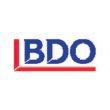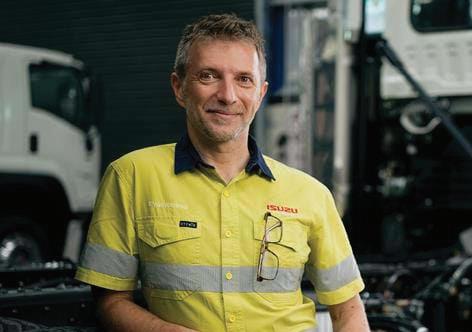






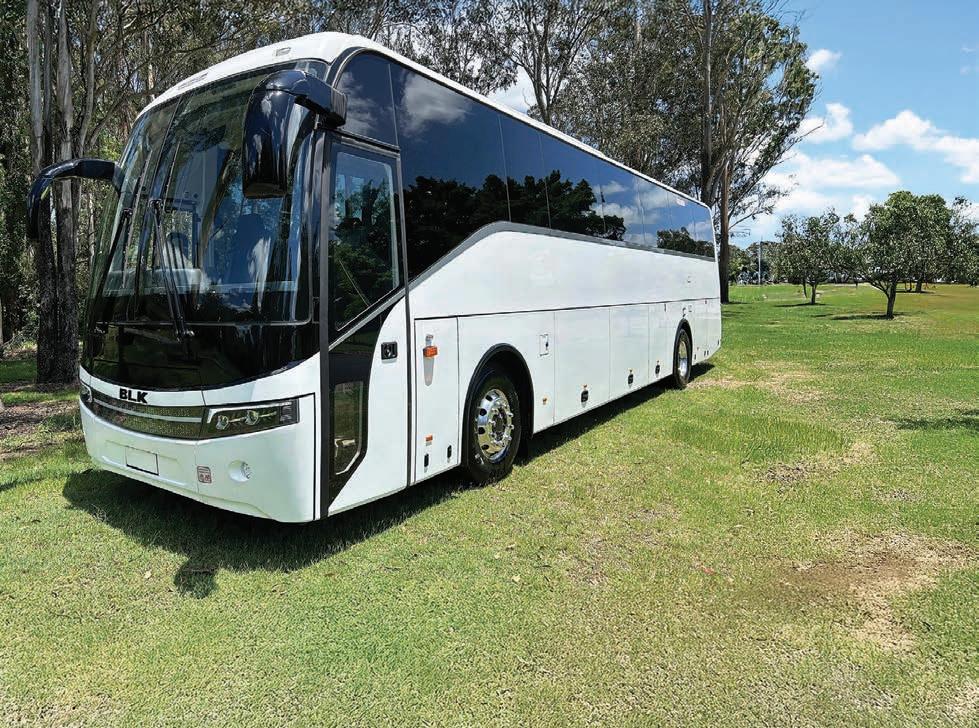


There are numerous examples in this month’s edition of ABC Magazine that prove the importance of unity within Australasia’s bus and coach industry
Even a casual fan of sports knows that a superstar team, rather than a team of superstars, always wins out. Since the dawn of time, a collective of people that pull together in the same direction is often a more powerful prospect than a talented group that is pulling in different directions.
In the aftermath of a critical federal election that saw one side of politics emerge united and with more standing than has been previously seen in the recent history of Australian Parliament, it’s a stunning reminder of the potential that the bus and coach industry has. This need to unite and push for change together that came to fruition on May 3 was predicted in the weeks prior by our new Bus Industry Confederation (BIC) executive director Varenya Mohan-Ram.
“I stand with you with a deep sense of responsibility in shaping the legacy of the industry into what it is today,” he said.
“We are meeting during a critical moment in time for the future of Australia as a whole, it’s time to reassess and unite.
page 27, our winding interview covers a range of talking points, from local content through to the need to unite all bus associations in Australia under the one banner.
Our cover story for this month underlines the success that our industry can have when collaboration is the key. While the Woodward family may not have naturally leaned towards transport, they did so out of necessity in the back half of the 20th century due to a need to promote their tourism business. Now, it’s resulted in VDI and Tropic Wings, with the pair’s combined electric bus network in Cairns paving the way for innovative and sustainable transport throughout Australia’s many regions. Check out the story from page 20.
Even a casual fan of sports knows that a superstar team, rather than a team of superstars, always wins out
“It’s essential that we speak with just the one voice. We’re not a collection of disparate parts. Operators are the heart of the industry and we thank you for your tireless work, while our suppliers continue to overcome challenges. Combined, the future of our industry will thrive if we collaborate.”
At the time, it got many heads attending the QBIC Conference nodding in agreement, so much so that my interview with Varenya shortly following his maiden speech since taking the post was interrupted on numerous occasions by industry members thanking him for his words. Fast-forward a fortnight and Varenya’s message of unity was once again reiterated by Labor’s landslide election win.
Let’s make this the blueprint for how our industry can achieve reform and overcome the numerous obstacles facing the immediate future. When talking to Varenya about the lay of the land at the QBIC Conference, it appears the industry has a new leader that is ready to tackle the big issues with politicians. From
In a time where there are various challenges being placed in the way of the bus and coach industry, it’s often easy to forget suppliers in the seating and internals sector. However, this edition is dedicated to the seating businesses that provide a critical part of every bus and coach in the nation. This year’s seating focus includes Sege (page 32), StyleRide (34) and McConnell (36), while McNaughtans highlights its Gerflor flooring product on page 43 and Ventura Systems discusses the importance of innovative door technology on the Brisbane Metro project from page 40.
Alongside our usual array of news, manufacturer stories, Best Bus winners and monthly deliveries stats, this May edition represents a pivotal moment in time for our industry. Let’s take the next step together. We hope you enjoy the read.

Sean Mortell EDITOR, ABC






06. editorial | ignition TIMETOUNITE
There are numerous examples in this month’s edition of ABC Magazine that prove the importance of unity within Australasia’s bus and coach industry
40. feature | ventura MOVINGMILLIONS
Ventura Systems’ advanced door technology is playing a large part in Brisbane’s recent public transport transformation
44. feature | yutong ROOTEDINSUSTAINABILITY
Regina Fellner
EDITORIAL & DESIGN
Managing Editor: Geoff Crockett
e-mail: geoff.crockett@primecreative.com.au
Editor: Sean Mortell
e-mail: sean.mortell@primecreative.com.au
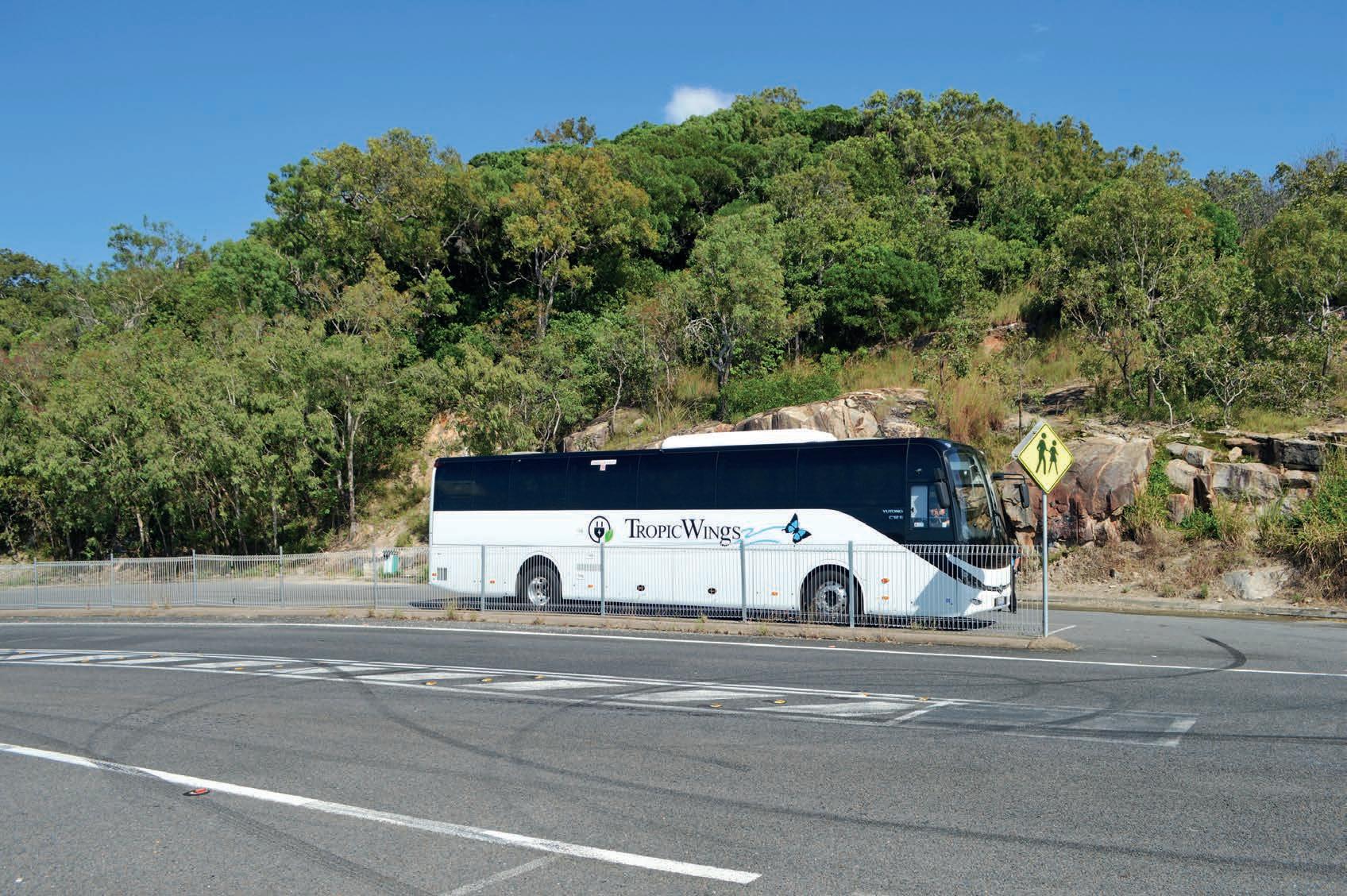
08. news | all aboard
Check out the latest news from around Australia and the world
features
20. cover story | vdi DRIVINGCHANGE
The story of VDI doesn’t begin with a bus. It begins in the rainforests of Far North Queensland, reports Sean Mortell
27. feature | bic EMBRACINGUNITY
Sean Mortell sat down with BIC’s new executive director to learn about his upbringing, beliefs and goals to lead Australia’s bus industry into a new era
32. feature | sege seats BUILTTOFIT
With Sege Seats and Irizar working hand-in-hand, ABC finds out how the partnership is redefining comfort and safety in the bus and coach industry
34. feature | styleride BUCKLINGUP
With major changes coming for the Australian bus and coach industry, StyleRide is stepping up to the plate
36. feature | mcconnell CUTTINGANEWFUTURE
McConnell Seats and Pathfinder Cutting Technology mark 20 years of partnership with a major technology upgrade
38. feature | bus safety TIMEFORACTION
Tiarna Condren speaks to BIC about how to better protect bus drivers against a recent rise in antisocial behaviour
As Australia accelerates its transition to clean transport, global bus giant Yutong is planting the seeds of change
46. feature | bus stop GREENERFUTURE
Hillcrest Christian College is leading the charge in sustainable student transport with the introduction of an all-electric King Long coach
48. feature | dulux COATINGCONFIDENCE
Dulux Automotive Coatings’ flagship range continues to deliver coatings that keep buses and coaches looking sharp
51. competition | best bus ROCKSTARS
The winner of ABC ’s Best Bus May comes courtesy of John Louder and a dynamic shot of a bus trio
54. factory facts | bus deliveries APRILDELIVERIES
Check out the latest bus and coach supplier sales data collected and recorded for you to review and see how the market fared in April
58. back seat | celebrating 50 years ALLABOARD
A retired 1977 Leyland Atlantean has found a second life as the Funpad, a fully mobile soft play centre delighting kids and surprising parents
Assistant Editor: Tiarna Condren e-mail: tiarna.condren@primecreative.com.au
Art Director: Daz Woolley
Designer: Apostolos Topatsis
PRINTING
Brougham Press
ADVERTISING
Sales Manager – South: Courtney Burton ph: 0481 736 890 e -mail: courtney.walker@primecreative.com.au
Business Development Manager – Bus: Adrian Kos ph: 0413 777 670 e-mail: adrian.kos@primecreative.com.au
SUBSCRIPTIONS www.busnews.com.au/subscribe ph: +61 (0)3 9690 8766
Mon-Fri 8am-4.30pm (EST) e -mail: subscriptions@primecreative.com.au mail: 379 Docklands Drive, Docklands VIC 3008 Australia
Annual subscription rates (12 issues): Australia: $99* Overseas: $A170 (Australian air-mail only) *price includes GST
Cover image: VDI

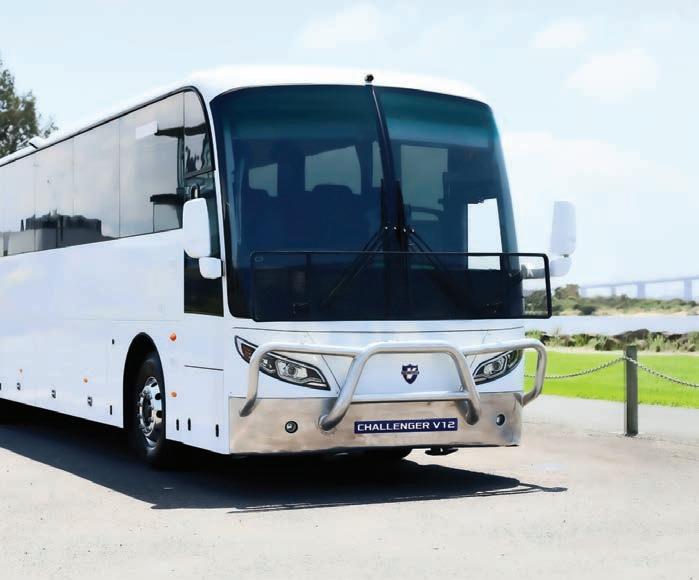


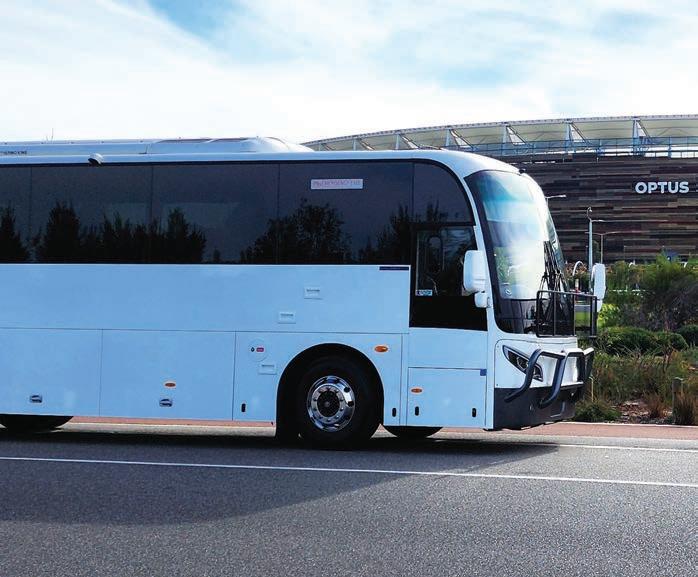
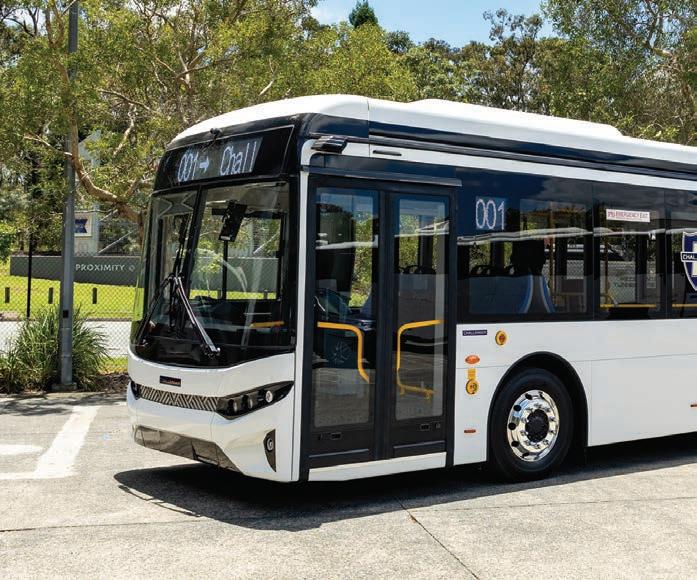
The minister then went on to list reform that she wants to see occur to make buses a more popular form of transport in the state
Victoria’s public transport minister has spoken about the need to invest in the state’s bus industry at a conference in May, calling buses the “poor cousin” in Victoria’s public transport network.
“Buses have always been the poor cousin in our public transport network, particularly when compared to trams, and it’s not fair,”
Gabrielle Williams told the PTAANZ ‘Moving People, Transforming Cities’ symposium in Melbourne.
“They’re much loved and well utilised in other jurisdictions in Australia, but in the broader Victorian community, people don’t feel like bus services meet their needs.”
Williams says the time for bus in Victoria is now, labelling various ways the state can improve its bus network to make it more appealing to passengers.
The first point is to provide more direct and frequent services –while this may mean routes will be altered, the goal is to reform bus routes so that they can travel more often and get people to their destinations quicker.
This may mean passengers have to compromise with not always having a bus stop 100 or 200m from their houses. Instead, a little bit of a further walk may result in more buses, more often and at a faster speed.
“We know that when we deliver what people tell us they want, they’ll use the services and vote with their feet,” Williams says.
“We have an exciting opportunity ahead to deliver a more modern bus service that integrates well with other projects in the state.”
Williams was then followed by secretary of Victoria’s Department of Transport and Planning, Jeroen Weimar, who admitted that he wants the state’s zero-emissions bus transition to be completed quicker than its current pace.

Above: Williams says the time for bus in Victoria is now, labelling various ways the state can improve its bus network to make it more appealing to passengers. Image: Infrastructure Victoria
“The first 89 buses are here, but I’d like to see us do more a bit quicker,” he says.
Advocacy group Sustainable Cities has long been advocating for improvement to bus services in Melbourne’s western suburbs, saying “it is comforting to know that the community’s demands and concerns are being heard”.
“We’re glad that Williams has publicly acknowledged the tragedy of the bus network. The next step is for the government to step up and allocate funds for reforming the bus network in the upcoming state budget,” Sustainable Cities spokesperson Elyse Cunningham says.
“The residents of the west cannot be left behind any longer, they also deserve the range of transport options that residents in other areas of Melbourne have.”
In August last year, the advocacy group started a parliamentary petition calling on the Victorian government to
commit at least $100 million additional annual operational funding in the next budget cycle. It also requested a capital investment of at least $100 million to reform the bus network across the Western metropolitan area into a fast, frequent and connected grid, serviced by clean, electric buses.
“Our petition, which was tabled in parliament in November last year, gathered over 3,000 signatures in support of better buses in the West. The people have told the government what they want, and they will, as Williams stated, vote with their feet,” Cunningham says.
“The government needs to demonstrate that it is serious about bus reform in the west and that there is substance behind Minister Williams’ recent comments.
“It cannot continue with business as usual by only adding or upgrading individual routes. The next state budget must show a clear commitment to reforming the whole network.”
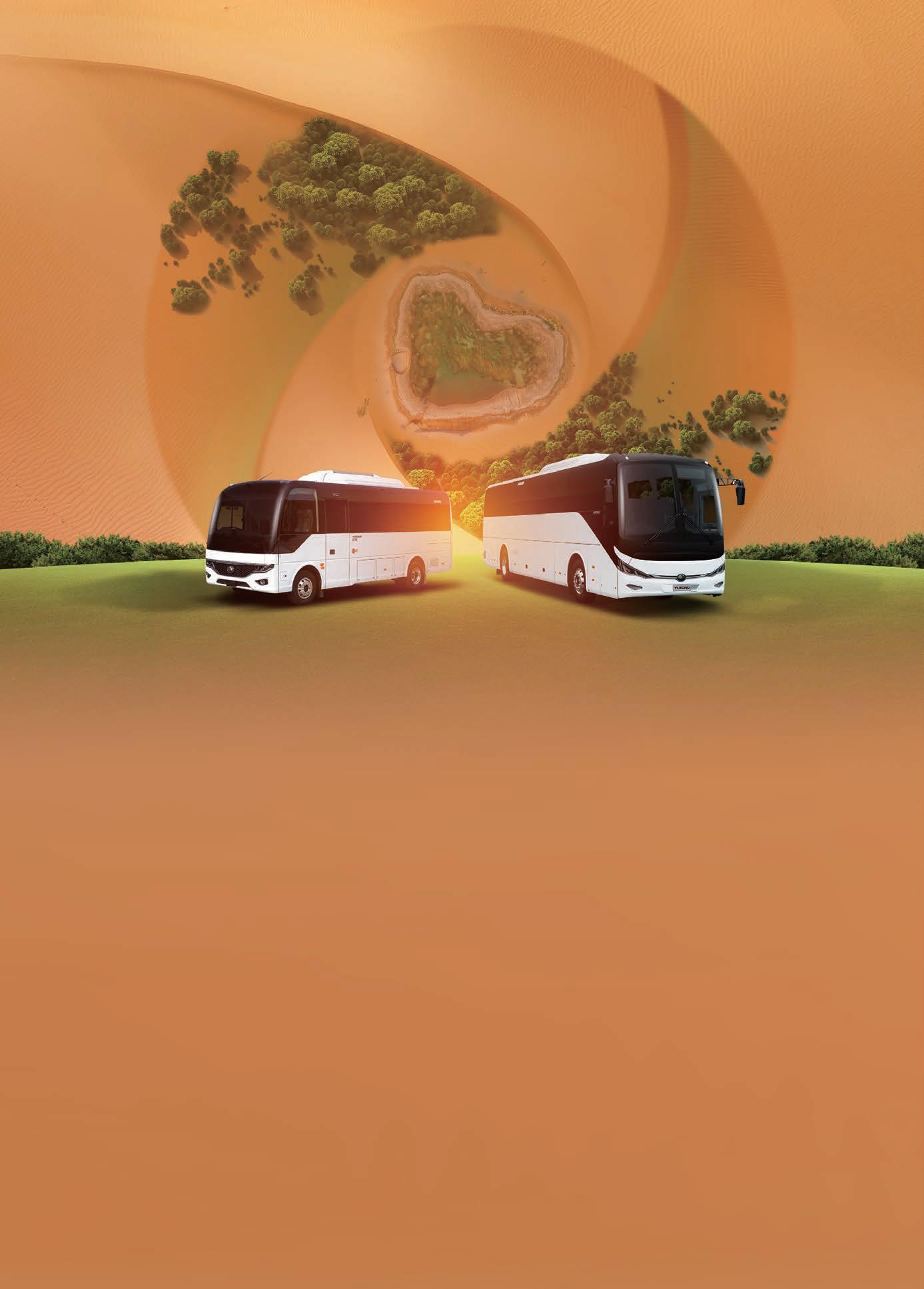

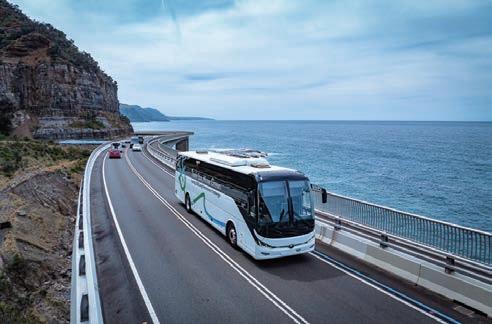

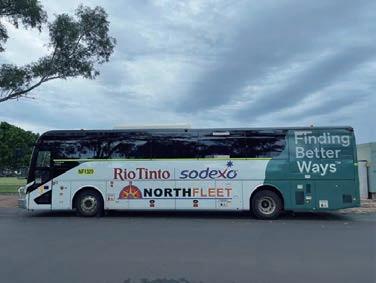

The new contract will see SkyBus continue its current services while picking up additional runs and bus upgrades
SkyBus is expanding its services to offer both landside and airside transportation, signing a new multi-year contract with Melbourne Airport.
The company, owned by Kinetic, already provides express bus services between Melbourne Airport and the CBD, as well as the CBD and Avalon Airport.
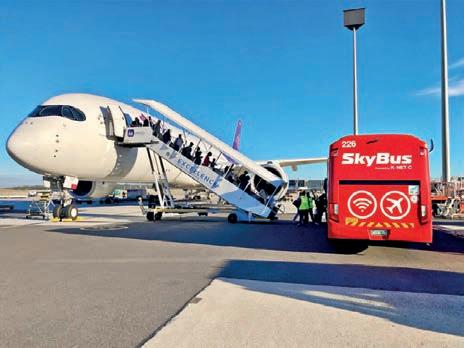
commenced in April, includes airside buses not previously provided by SkyBus, as well as new on-board information displays for the buses operating to the airport’s value car parks.
“SkyBus has been with us for more than 30 years and we look forward to continuing to work with the team to deliver a seamless, integrated experience for our travellers,” Melbourne Airport chief of aviation Jim Parashos says.
“This new contract will enhance the ground transportation services, with SkyBus extending its expertise to provide airside bus services on the tarmac.
A north coast-based operator has been contracted to provide the services using two NSW TrainLink branded coaches
Coaches will soon replace trains for passengers travelling between Sydney and Grafton, with NSW Trainlink aiming to “revamp” the state’s long running regional workhouses.
Having started on April 28, the coaches will run in place of the 5.15am Grafton to Sydney and the 11.44am Sydney to Grafton train services. This arrangement will run for 12 months. In an effort to keep travel time as close to the train trip as possible, the coaches will not stop at all regular XPT stations.
NSW TrainLink acting chief executive Yvonne Hinch says the Sydney-Grafton temporary premium coach service alongside the XPT Life Extension Project is aimed at improving the overall travel experience for passengers.
“The work we are doing on the XPTs, from overhauling the mechanical systems to refreshing interiors and essential amenities, will mean passengers, can look forward to a cleaner, more comfortable, and dependable journey,” Hinch says.
“These passengers include those who use our services between Grafton and Sydney services, who will experience a temporary change in mode of transport, with the intention to return train services on that route at the end of that period.
“By carefully implementing this temporary service change, we aim to keep journey times reasonable while maximising connections with other public transport modes, including with other NSW TrainLink services.”
Forest Coach Lines has been contracted to provide the services
“By 2042 we expect to be welcoming more than 76 million passengers a year, so it’s vital that we continue to strengthen our transport solutions for our passengers.”
Kinetic CEO Michael Sewards says SkyBus is now in its fourth decade of operations at Melbourne Airport, and carries close to three million people every year.
“SkyBus is a well-established airport player, with a large and growing international footprint and a long history in providing airport and transfer services,” he says.
“We’re proud to continue working with Melbourne Airport and support its continued growth and success.”
using two NSW TrainLink branded coaches which will be air conditioned and have toilet facilities.
Two premium wheelchair accessible coach services options will be available with express run or selected stops service in place of the regular XPTs between Sydney and Grafton.
Commuters on the north coast will still have four daily rail options with the Sydney to Brisbane and Sydney to Casino services, as well as existing regular NSW TrainLink coach services. Local timetabled buses will also connect travellers to services.
The temporary change will make rolling stock available to ramp up a vital maintenance and refurbishment program to bring new life, reliability, and comfort to the XPT fleet which has been in service for 43 years.

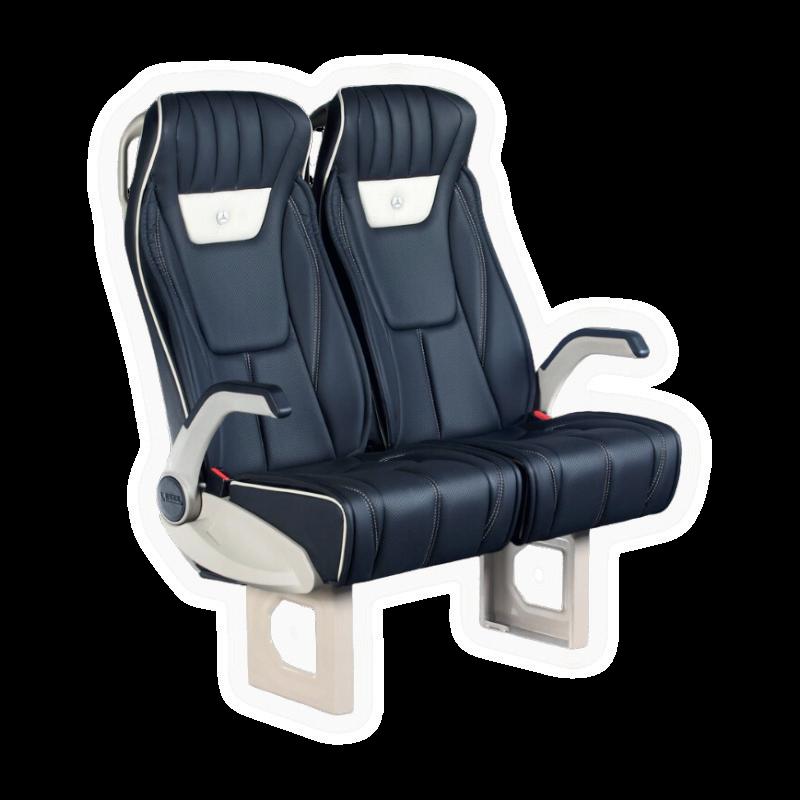



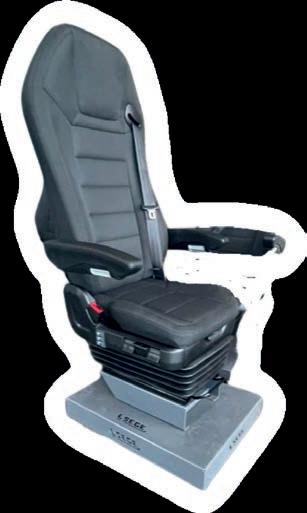
Verified quality supplier of high-quality seats to the Asia Pacific Region, encompassing Australia, New Zealand, North America, Brazil, Canada, Thailand, Singapore, Malaysia, and Indonesia.
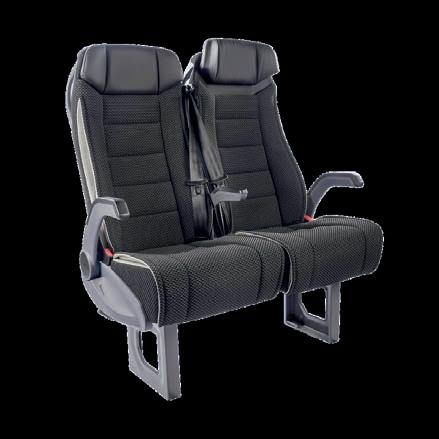

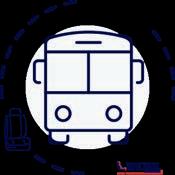

With our car rental services, the adventure begins as soon as you hit the ignition. Quality Assurance
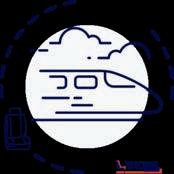

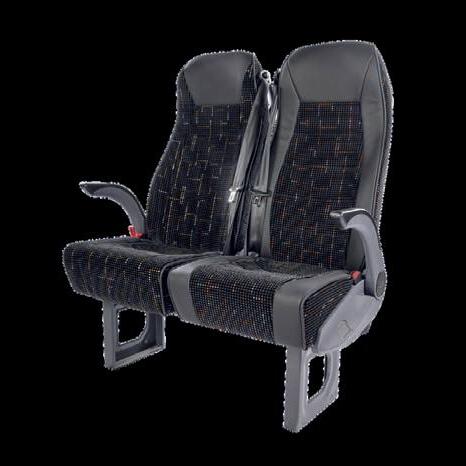
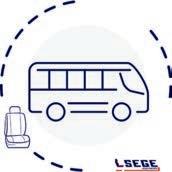
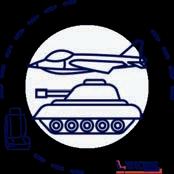

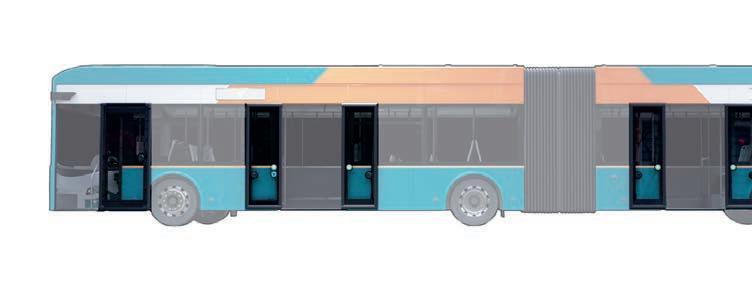

A town hall meeting on the Gold Coast Light Rail Stage 4 review saw hundreds of community members gather to discuss the future of public transport on the Gold Coast
A town hall meeting held at Palm Beach and attended by Deputy Premier Jarrod Bleijie and local MPs ia forming part of the Queensland government’s election commitment for a review into the Gold Coast Light Rail Stage 4 project.
The review will assess all the routes, public transport modes and connectivity options to develop a detailed profile of connectivity and transit needs that ensure future transport options serve the needs of the local community.
Since consultation became open to the public, over 3,800 submissions have been received.
“We know Gold Coast residents want their voices heard on this matter, and that’s exactly what the
town hall meeting was about,” deputy premier Jarrod Bleijie says.
“The Crisafulli Government is committed to true community consultation and will not railroad communities like the former Labor Government.
“The venue was packed with people wanting to hear from government and to voice their concerns about the former Labor Government’s proposed Stage 4 Light Rail Project.
“Last night’s turnout clearly demonstrates Labor’s previous consultation was a sham, and Southern Gold Coasters have not felt heard until now.”
It was revealed that the former government didn’t disclose to Queenslanders that the extension
puts 235 properties at risk of resumption and could result in the loss of 1,000 local car parks.
Member for Currumbin Laura Gerber says meetings like these are the first steps to delivering greater transparency.
“We are putting this decision back in the hands of the community like we promised, ensuring proper consultation is undertaken and the community gets the transport solutions that best meet the needs of the Southern Gold Coast,” Gerber says.
“We are delivering on our commitment with a transparent review, and we have released the previously hidden documents so locals can make informed decisions that affect their lives.”
Mark Harbridge has been announced as the man in charge at the new Foton Nowra EV bus facility, overseeing the production of 126 Foton BEV City buses over the next two years.
Taking the role of production manager, Harbridge’s extensive background in asset management for Transdev, CDC NSW and through his own consultancy stand him in good stead for the challenge of managing the production of the EV buses to meet Foton Mobility Distribution’s (FMD) contract with Transport for NSW.

“With experience across Asset Management, Safety and Environment, Mark is well equipped to ensure that the EV buses meet the highest standards demanded by the terms of the Contract,” a statement from KRW Hydron reads.
Below:
The first EV buses are destined to roll out of the interim facility by mid-2025. Image: Foton
FMD has recently obtained a temporary premises, covering 1900sqm, which will undergo several weeks of refurbishment and fit-out to prepare it for the arrival of the first batch of chassis and parts by the end of May, and to allow training of the new employees beforehand.
Job adverts will shortly appear for
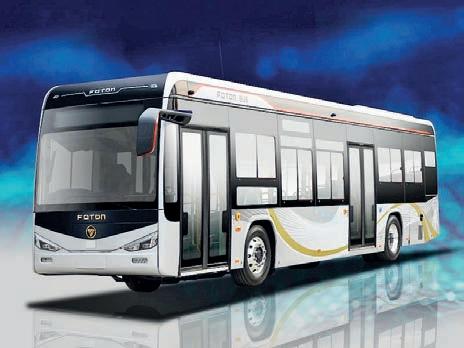
the up to 15 staff required to operate the facility initially.
A DA has been submitted to Shoalhaven City Council by its associate KRW Group for a permanent 6,000sqm EV bus factory that will see the manufacturer produce buses, battery electric trucks and hydrogen fuel cell engines.
The first EV buses are destined to roll out of the interim facility by mid-2025.
Earlier this month, GoZero Group sold its 50 per cent share in FMD to FMD joint owner and CEO Neil Wang and bus industry veteran Scott Riley. The sale of FMD to Wang and Riley will allow GoZero to instead focus on building towards its goal of being Australia’s largest owned manufacturer of battery electric buses through its Nexport and BusTech brands.
Katie Cooper will be stepping down from the top role while driver shortages and privatisation concerns still persist
Katie Cooper, Metro Tasmania CEO, will not renew her contract when it expires on October 11, 2025.
At this time, no successor has been announced.
Metro Tasmania board chair Tony Braxton-Smith told Pulse Tasmania that the company acknowledges Cooper’s “commitment and dedication over the past five years” and her “capable navigation of the organisation through the impacts of the COVID-19 pandemic”.
“On behalf of the Board, we thank Katie for her efforts and wish her well in her future endeavours.”
The announcement comes at a challenging time for Metro, which is currently struggling with

significant driver retention issues across its network and conversations surrounding privatisation.
Metro has been forced to cut bus services over the past 12 months due to a nationwide shortage of drivers, launching an aggressive recruitment campaign to entice more drivers to
The Woden depot in Canberra is the first bus depot in Australia to be able to shelter up to 100 electric buses
The doors to Canberra’s new Woden depot have finally opened, with the first bus services kicking off from April 28.
The $90.5 million-dollar state-ofthe-art facility is the future home of the ACT’s zero-emission bus fleet. It will also be the first bus depot in Australia to be able to shelter up to 100 electric buses.
Below: An improved timet able has been developed to increase service frequency. Image:
ensure the right infrastructure is in place to support the charging capabilities of the depot, with 96 buses able to be charged simultaneously.
Regular bus services will align with an improved bus timetable that kicked off at the start of the second school term.

jump onboard.
Last month, members of the Rail, Tram and Bus Union (RTBU) and opposition MPs gathered outside Metro Tasmania headquarters to protest the state government’s refusal to rule out privatising the operator.
The protest comes amid ongoing concerns about driver shortages, unreliable services and a failure to deliver promised safety improvements.
Fears of fare increases, service cuts and deteriorating working conditions for drivers were top of mind, with Labor’s shadow transport minister Meg Brown condemning the privatisation agenda.
weekday. This includes more morning and night weekday peak services, more weekday and Saturday services to better connect the growing Molonglo region and improved services for local schools.
“Integrating the new Woden bus depot into our network allows Transport Canberra to improve the efficiency and reliability of our services and encourage even more people to catch public transport,” a Transport Canberra statement reads.
“Buses can now operate out of Woden and service the region, instead of driving from our depots in Belconnen and Tuggeranong. This reduces out of service run time and allows us to be more responsive and flexible in our bus operations, such as providing more weekday peak services for Rapid buses and improved school services.”
Despite some concerning offences picked up across the national operation, the NHVR has heaped praise on the industry’s safety standards
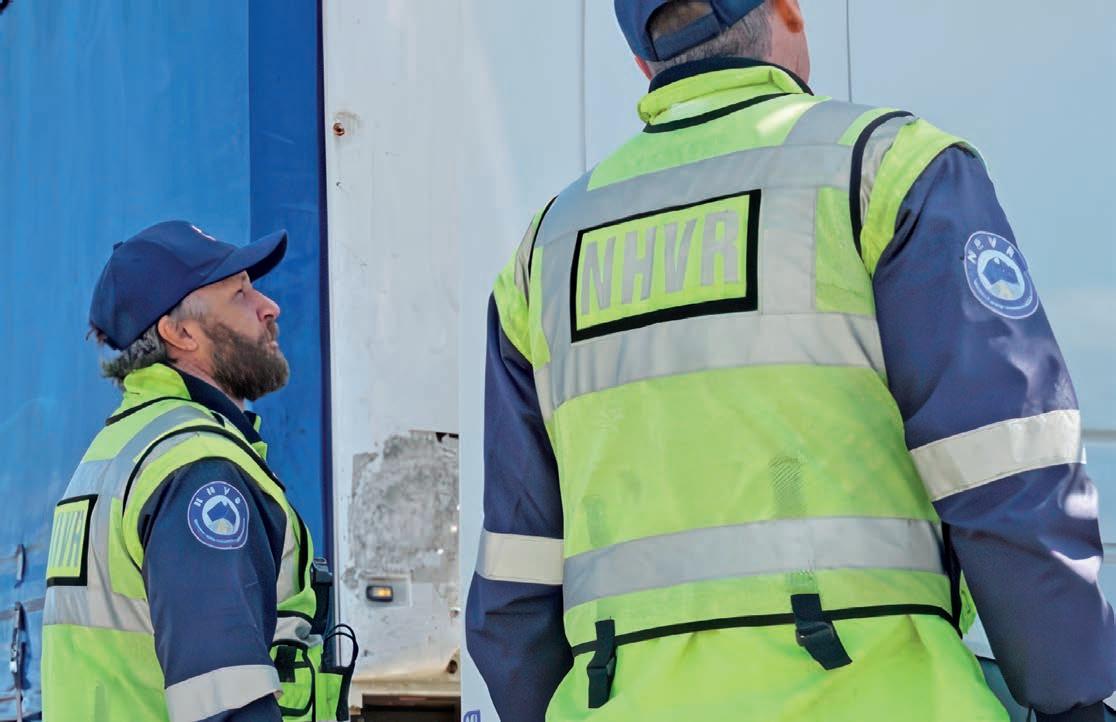
The National Heavy Vehicle Regulator has provided more details on the results of its national bus operation ‘Operation Solstice’.
NHVR chief operations officer Paul Salvati presented the results at the recent QBIC Conference, saying the operation was “a huge effort by all involved” and crucial to improving safety within the industry following recent tragic crashes involving buses in recent years.
“Operation Solstice targeted a range of critical compliance areas including ensuring buses were properly maintained and mechanically safe, and that drivers were complying with their work and rest hours,” he says.
“With more than 80 lives lost in crashes involving a bus in the past five years, we knew more needed to be done so the community can have every confidence in the fact that buses, which are a vital part of our transport system, will get them to their destination safely.”
Before the operation commenced, the NHVR hosted a series of
intercepts occurred during the operation, with 432 notices provided. Image: NHVR
industry to discuss safety concerns and provide a briefing on the upcoming Operation Solstice – discussing key topics like fatigue, Chain of Responsibility and vehicle standards.
“While we know most drivers do the right thing, the results of this month-long operation demonstrate that not all drivers and operators within the industry are compliant or are aware of their safety obligations under the Heavy Vehicle National Law (HVNL),” he says.
A total of 2,266 intercepts occurred during the operation, with 432 notices provided.
“We found an overall non-compliance rate of 19.1 per cent with mechanical and fatigue the highest areas of offending, although on a positive note, most mechanical non-compliance was minor,” he says.
“While this non-compliance rate is lower than what we usually see amongst general heavy vehicles, given the cargo carried by buses, this is still a concern.”
Mechanical offences (16.5 per cent)
per cent) being the only other offence recorded in buses.
Breaking down the mechanical offences section, Salvati says ancillary equipment was the leading defect component, accounting for 22 per cent of the offences. However, it only resulted in five major incidents, with engine, driveline and exhaust leading in this regard with six (and 12 per cent of total defect incidents).
Seats and seatbelts accounted for 10 per cent of the offences, with registration, lights and reflectors, windscreens and windows and structure and body condition all close behind with nine per cent each.
Salvati singled out the low ranking of brakes, with only seven per cent of incidents and four major incidents being attributed to brakes.
Looking forward, Salvati says the NHVR is holding meetings with BIC to receive further feedback and develop a harmonised procedure for bus inspections so drivers know what to expect when intercepted by the regulator.
Irizar Asia Pacific has announced the appointment of Wagner Luiz Moraes to the role of national service manager, set to kick off his new role at the Melbourne headquarters
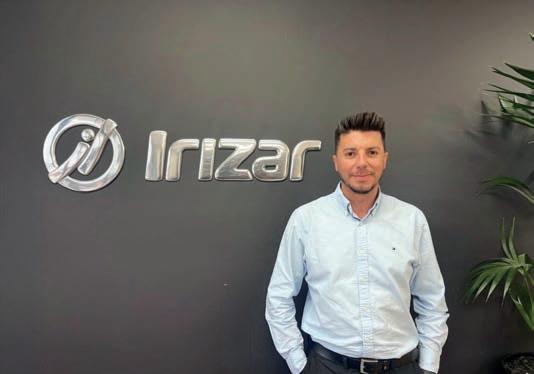
quality and performance to Irizar’s operations.
Luiz Moraes’ career spans continents from South America and India to Australia since 2019, developing through his roles with several prominent companies in the bus
experience in bus manufacturing and production management to the role. Image: Irizar
industry, most recently with Volgren.
His technical foundation includes certifications in boilermaking, welding, sheet metal, production automation and heavy vehicle operation, complemented by a degree in business administration that has enabled him to hold roles leading continuous improvement, production management and quality control.
“I specialise in deploying process improvement methodologies such as Lean, Kaizen, Six Sigma, Value Stream Map (VSM) and 5S,” Luiz Moraes says.
“But it’s my hands-on expertise that fosters effective collaboration with teams, engineering, sales and customers.
“My focus is on ensuring seamless integration of processes from development to delivery. I look forward to utilising my skills in delivering an aftersales experience that instils confidence in the Irizar brand and long-term partnerships with our growing customer base in the Asia Pacific region.”
Irizar Asia Pacific managing director Steve Heanes says he has confidence in the growing team.
“It’s been an exciting 18 months for our Asia Pacific operations. Having invested in new headquarters and expanding our field service fleet, we’ve been sure to equally invest in our people,” Heanes says.

Under instructions from Ryan Bros Bus Service due to end of contract, Pickles is inviting expressions of interest for 11 Mercedes-Benz LE 500 route buses, manufactured between 2011 and 2024, each fitted with Volgren bodies.
The vendor is open to offers and may sell prior to the closing date.
In April, legends of the Queensland bus and coach industry were celebrated as the state handed out its annual awards
Following a well-attended day at the Queensland Bus Industry Council (QBIC) conference, the gala dinner at night played host to the industry awards ceremony.
Sponsored by Bus Stop Sales, director Pete White started the night’s proceedings by welcoming the room full of attendees and providing an engaging insight into some of the brand’s leading bus and coach technology.
From high- and low-floor developments in its King Long range through to plans for zero-emissions bus training programs, Bus Stop re-asserted its commitment to help grow the local bus industry.
The first award handed out was the Manmeet Sharma perpetual professional driver of the year award, with Katherine Collins from Transport for Brisbane receiving the special recognition.
“I’m absolutely shocked, when I was told I was a finalist I cried,” she said upon receiving her award.
“Thank you very much for those who nominated me.”
The next award went to Brisbane Bus Lines, with Ian Mitchell receiving the outstanding contribution award.
“My family first started in road transport in 1937 when my dear
edgement from my peers. I never t work hard to provide good, reliable and safe transport for communities.”
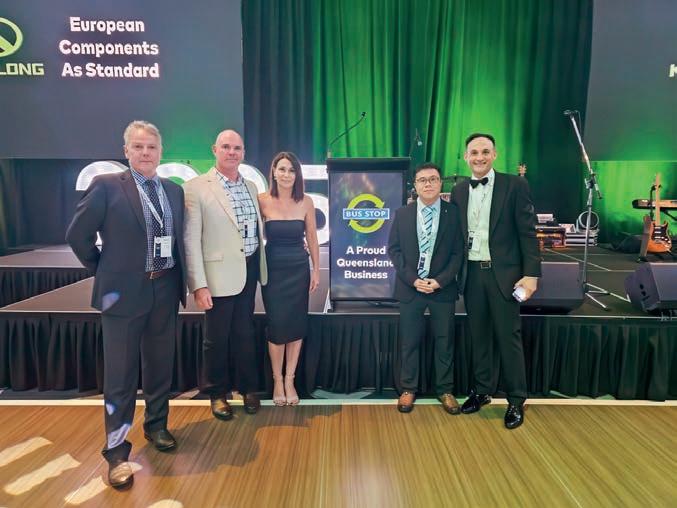
Transport for Brisbane continued a strong night, taking home the environmental innovation award.
The coveted supplier of the year award went to Vehicle Dealers International (VDI), the Australian distributor of Yutong buses, with VDI managing director Peter Woodward on hand to accept the award.
Scania Australia took home the outstanding employer of the year award, while the Aaron Pitt and Lleyton Bartlett perpetual apprentice of the year award went to Damian Brown from Emerald Coaches.
“What an incredible honour,” he said. “It’s something I never expected and I’m truly grateful.”
The achiever of the year award went

innovators who worked tirelessly to pave the way for the future,” she said. A variety of long service awards were handed out, including to Brisbane Bus Lines (60 years), Hornibrook Bus Lines (90 years), Transport for Brisbane (100 years) and Minden/ Gatton Bus Service (30 years).
Translink also handed out its bus driver of the year awards, with Isapella (Bella) Tuimavave Leaupepe of Hornibrook Bus Lines winning the south-east Queensland division, Sam Davison from Bus Queensland Toowoomba taking home the regional award and Bus Queensland’s Allan Humphrey winning the school award.

















Another dozen buses are expected to hit the roads before midyear, ushering in a new era of public transport in New Zealand
Passengers on Dunedin’s public

The new Chinese-built Geely C13E 75-passenger electric bus is the first to start plying the route between Mosgiel and Dunedin, delivered and operated by Kinetic-owned Go Bus.
By July, six of these high-capacity electric buses will be on the road as part of a new 13-vehicle electric fleet transforming public transport for the growing Mosgiel community.
The Kinetic fleet will include six large buses, six standard-size EVs, and a smaller 22-seat, wheelchair-accessible vehicle for a new On Demand service.
“This is an exciting milestone for our team in Dunedin,” Go Bus COO Ben Barlow says.
“The arrival of our first zero-emission, 75-passenger electric bus marks a major step forward in delivering cleaner, more sustainable public transport for the region.”
The first large EV entered service in early April, with more arriving throughout May and June. Delivering the vehicle early allowed local drivers to undertake comprehensive
training and gain valuable experience operating the new model across varied terrain — from highways to residential streets.
“The feedback so far has been fantastic,” Barlow says.
“Passengers are loving the quieter, more comfortable ride, while our drivers appreciate how smooth and responsive the vehicle is to operate.”
To support the new fleet, Kinetic has upgraded its depot on Dukes Road in Mosgiel with state-of-theart charging infrastructure that was completed ahead of schedule. The depot will serve as the primary hub for the electric vehicles.
The introduction of electric buses to Dunedin’s network builds on Kinetic’s broader commitment to sustainability across New Zealand.
Over the next several years, diesel buses will continue to be progressively phased out as contracts renew, supporting long-term emissions reduction goals for public transport.
The new buses, including 26 doubledeckers, will run every 10 minutes on AT’s WX1 Western Express frequent service from Westgate to the city centre via the Lincoln and Te Atatū bus interchanges.
The new buses will also replace current diesel buses on the 11T, 11W and 12 routes in the coming months.
Auckland Transport (AT) fleet specification manager Edward Wright says Auckland is now well on its way to hitting its 2030 target for the electric transition.

Auckland now has 224 electric buses, with AT saying it operates more electric buses than any other city in Australasia.
“Each of these new double-decker
electric buses can fit 100 passengers, and we have boosted capacity on the WX1 service by an additional 7333 seats every weekday, and 51,000 seats every week,” Wright says.
“We’re adding another 31 electric buses to our fleet by the end of June. By August next year, we will have a fleet of 450 electric buses, which is around a third of the 1350 buses that operates AT’s services.
“Longer term, we have plans in place for Auckland’s bus fleet to be fully electric by 2035.”



A modern, innovative collection of flat woven material with leather borders suitable for bus and coach interiors. Combining colour, pattern and textures, we have developed a collection of fabrics for a variety of bus applications. Released in 3 patterns and 4 highlight colours with matching plain, this range inspires the imagination. Verve is foam backed as standard making upholstering easier.

Designing and Manufacturing seats in Australia for over 70 years
Features Your passengers will experience spacious comfort in this new range of Verve seat covers.
• 100% leather borders
• Contemporary look and feel
• Extensive range of fabrics
• Hard wearing
• Easily cleaned
• Low maintenance
• UV stabilised
• Fire resistant
E:
McConnell is the largest designer and manufacturer of transport seating in Australia.
Achieving this level of success while remaining a locally operated company is a testament to the quality of our product and the integrity and service of our dedicated team.
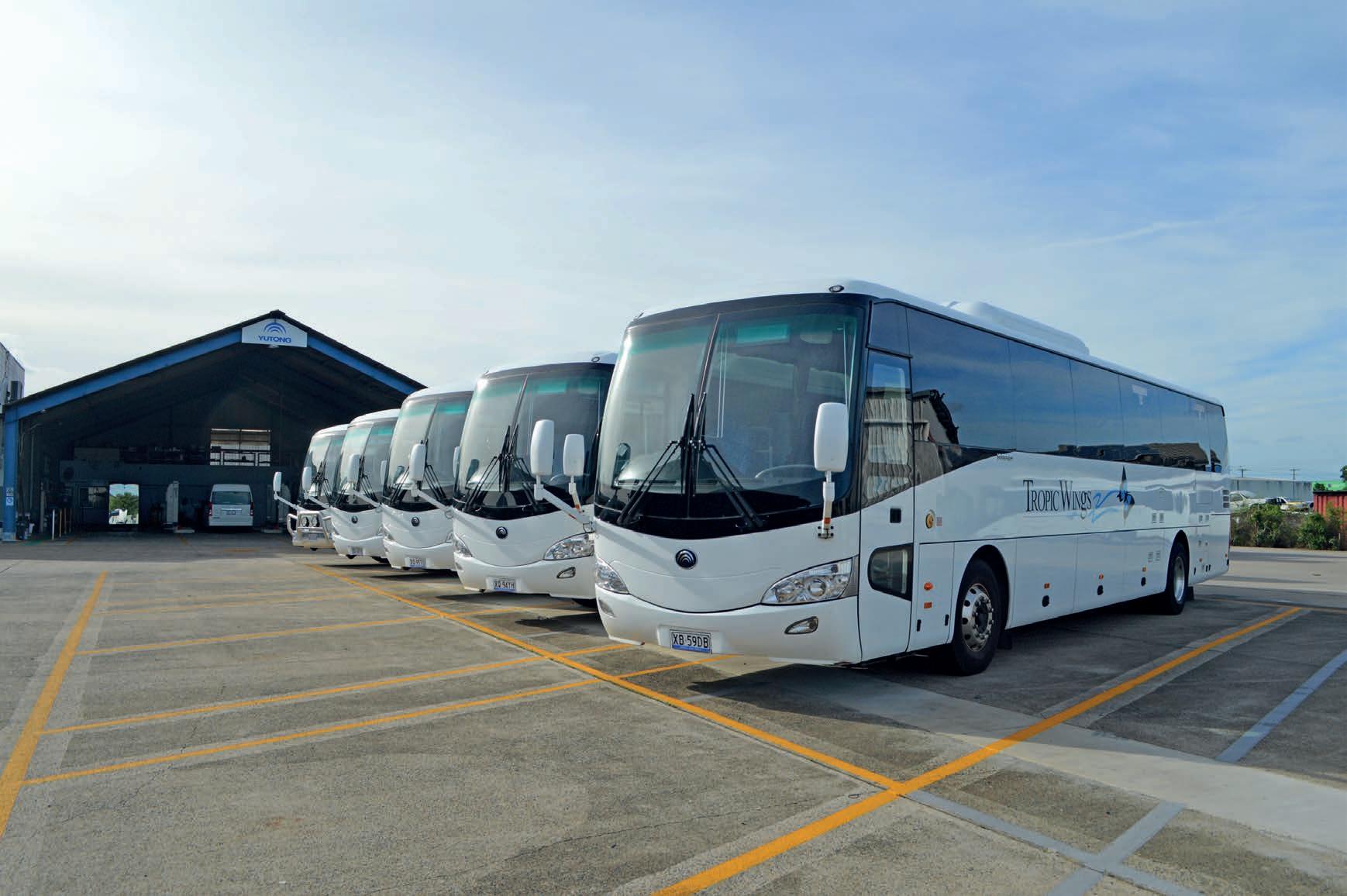
The story of VDI doesn’t begin with a bus. It begins in the rainforests of Far North Queensland, reports Sean Mortell
When the Woodward family launched the Rainforestation Nature Park in Far North Queensland, they quickly discovered a missing link. How do you transport visitors into the heart of the experience? Their answer, born from necessity, would eventually reshape the national bus industry.
Growing up, Peter Woodward didn’t dream of buses, only of where they could take you. It sounds like sacrilege, doesn’t it? How could the managing director of Vehicle Dealers International (VDI), one of Australia’s largest bus and coach suppliers, not grow up with a love for buses?
However, upon taking a step back and understanding the Woodward family story that started the best part of half a century ago in Far North
Queensland, the origins of VDI aren’t too dissimilar to the beginnings of many family companies that now shape Australia’s bus and coach sector.
Before April’s Queensland Bus Industry Council (QBIC) annual conference, I joined the VDI team in Cairns to see firsthand the remarkable story of how tourism and transport shaped a regional success story.
From the Daintree Rainforest to the Atherton Tablelands, the Woodward family’s mixture of tourism and transport has become a beating heart of Cairns and Far North Queensland. We had the pleasure of experiencing this success through the powerful partnership between VDI, Yutong and Tropic Wings. To get to this point, it’s taken years of hard work.
Like many operators, the Woodward family didn’t set out to
run a bus business, but necessity has a way of rewriting plans. In 1976, Charles and Pip Woodward opened the Rainforestation Nature Park in Kuranda, nestled in a former orange orchard on the edge of the Daintree, just north-west of Cairns and up into the mountains that surround the regional city. The setting was perfect, but the problem was access. Tour companies wouldn’t make the steep trip up the hill, so the Woodwards bought a couple of buses and started running their own service.
From that decision came Tropic Wings, the beginning of a tourism and transport legacy that would help shape Far North Queensland.
“We used to live onsite, as we were new to tourism, and run tours through the rainforest from the property,” Peter, the youngest of Charles and


Pip’s three sons, told “Due to the location, no one turned up to start with, meaning we had a problem.”
This is where the transport side of the Woodward’s story first began to take root, as the family had to quickly decide on a way to get people to make the trip to Kuranda and see Rainforestation before it was too late. Once people got up the hills to the site, the amphibious Army Duck tours and Colonial Restaurant would prove to be enough to entice people to keep coming back.
The family approached tour bus companies to take on the transfers, but none were willing. So, they took matters into their own hands.
move to purchase Tropic Tours in 1979 and Blue Wings soon after,” Peter says.
Wings, a name that is now
synonymous in the Cairns tourism and bus charter industries.”
It was a bold leap, especially for a family with no experience in running bus services. Peter admits there was “lots to learn straightaway”, but once Charles and Pip got Tropic Wings underway, it allowed Rainforestation to become a popular tourist attraction.
All throughout this evolution of the family’s business ventures, Peter, alongside his brothers Michael and Ben, grew up on Rainforestation, spending a lot of time in what’s known as Woodies Treehouse.
“It was always interesting living on
Dad was an accountant, so tourism and transport was all very new to him. My first memories were working at Rainforestation on the weekend and chatting to drivers while watching the
Woodwards, as they cashed in on what Peter refers to as “the golden age of touring”. At its peak, Tropic Wings had almost 30 vehicles in its fleet, with three coaches and up to 150 people heading up the Atherton
While in Cairns, we get to check out this route that was once immensely
Global Financial Crisis and COVID-19 pandemic, alongside the pilot strike in the late ‘80s and Ansett collapse in the early 2000s, may have brought this golden age to an end, but the run is still breathtaking as we wind our way through Gillies Range in a pristine Yutong C12 diesel model.
Reaching the top of the tablelands, the steep, winding road we’ve just driven highlights the challenge these routes pose for any coach. Our driver for the multiple days of trips and tours is Brian, who has been working in the past 18 years in tourism. While he once worked for a rival company of Tropic Wings, but he has been with

Yutong vehicles,” Brian told
“I grew to love them, and when we were introduced to the latest C12 series, they go even better.
“I do a lot of extended charter work from down south. When I’m taking a C12, I know I’ll get there in comfort — and my passengers will love it too. They have great turning circles for smaller roundabouts, and I’ve never had a problem when parking them.
“They’re quite a joy and I love driving any of their vehicles. Give me a Yutong any day and I’ll take it.”
A diesel bus that handles this route with ease is impressive in itself. But now, Tropic Wings is taking it a step further, running the same routes with Yutong electric buses.

The journey towards electrification began when Peter returned to the family business, the CaPTA Group, in the early 2000s. Leveraging his software expertise, he guided the company into a new technological era.
After two years as Yutong’s dealer in North Queensland, the company seized the opportunity to host Yutong’s annual APAC Golf Convention in Cairns – the first time it
“We came to an agreement, we had been having discussions with the Yutong team about providing further support for the brand throughout Australia,” he says.
“They all came out to Cairns, and we finalised a deal that saw VDI created to take over service and support for Yutong buses in Australia.”
That same year, VDI was appointed as the official local distributor of all Yutong spare parts in Australia. By 2018, it had expanded its role to become the official national
from addressing transportation gaps for Rainforestation visitors to directly supplying advanced bus and coach technology to its tourism operations.
“It all came about unexpectedly, stemming from several changes that occurred from 2013 onwards,” Peter says.
“When Dad got sick and passed away from cancer in 2017, I took the challenge on and saw a way of diversifying our business away from relying solely on tourism, which had taken a hit due to various events.


“The rationale behind expanding VDI into the national distributor of Yutong buses was to diversify our regional beyond tourism, granting us a national footprint.”
When the COVID-19 pandemic brought tourism to a halt, the prior expansion of VDI proved crucial. Its continued growth enabled the CaPTA Group to navigate the lockdowns and emerge with renewed strategies.
The group aimed to revolutionise sustainability in Far North Queensland by introducing electric buses and coaches to Tropic Wings.
“When COVID hit, our family had to decide what was best for the business’s survival amid many unknowns. My wife Jaci suggested we move to Brisbane to focus more on VDI, making it easier to access Melbourne and Sydney offices,” Peter says.
“Having a strong OEM partner in Yutong was beneficial – we always valued their diesel buses and noted their continuous improvements. In 2017 and 2018, we began exploring electric models in Australia, recognising Yutong’s strength in this area and its potential as the future of transport.”
Following EV trials in Canberra and Nowra,, VDI introduced an electric model to Cairns for Tropic Wings to test in the region’s challenging conditions. Its strong performance and encouraging data meant the E12 was ready to be joined by a small fleet of fellow electric vehicles.
“We took that model up a significant mountain every day to see what advantages electric models had for sustainable tourism,” Peter says.
“There were lots of positives –passengers and the city loved the lack of noise and emissions that would come out of the bus when we’d drive through restaurants in and around Cairns. Customers found it to be a quieter and more enjoyable experience.”
During our visit to Cairns, we toured Tropic Wings’ depot just five minutes out of the city centre. Though modest in appearance, the facility houses advanced technology, marking a significant milestone for the Woodward family.
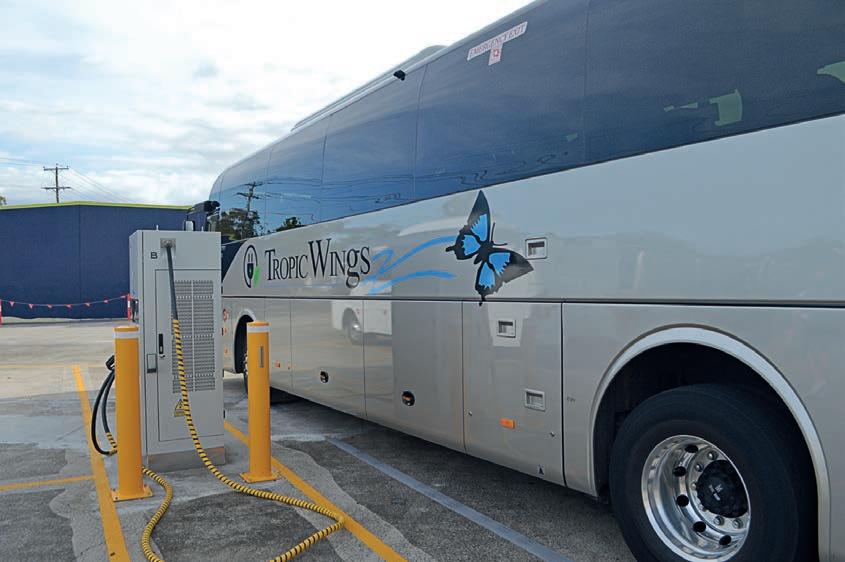
“Following our 2019 E12 trial, we decided to bring another 12 electric buses in, aiming for 80 per cent of Tropic Wings’ fleet be electric by 2030,” Peter says.
“Introducing the 12 electric buses and their supporting infrastructure was far more challenging than the initial trial. We underestimated what was involved, but last year we finally made it all work.”
Tropic Wings’ modest electric bus depot, nestled at the foot of the Atherton Tablelands, is quietly revolutionary. At a recent global tourism event, Peter shared the story
about what they had managed to do in Cairns, and the international audience was stunned.
“It’s pretty special to do something so massive for sustainable transport and tourism in Australia,” he says.
“We’re proud to be trailblazers and we’re keen to see the uptake elsewhere.”
Part of the Cairns trip was designed to give other Queensland operators a chance to see Tropic Wings’ electric Yutong buses in action.
While Murray Priebbenow may be managing director of the Fraser Coast’s Wide Bay Transit hours south
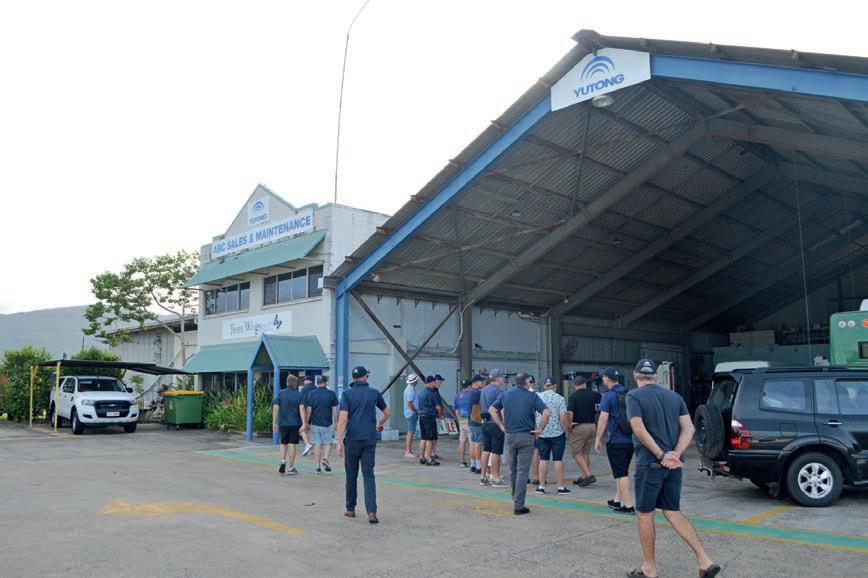

the combination of VDI’s Yutong buses on display and Tropic Wings’ groundbreaking depot.
“I always have a diesel D7 in my fleet, so it was wonderful to drive the electric version – I found it to be smoother without the front engine weight,” he told ABC
“I wanted to go electric in Hervey Bay, as it would’ve been wonderful having electric buses down main streets where people sit outside at restaurants and cafes, but it didn’t end up working out. Seeing this firsthand has been a highlight, it’s been great to see how Tropic Wings and VDI have worked together to meet the latest trends in the electric market.”
While he may have Victorian roots, Adam Pulitano is now a well-known member of Queensland’s bus industry. The Bus Queensland managing director was left impressed by both Tropic Wings’ innovative electric bus operations and the way in which VDI has grown to become a popular bus and coach distributor.
His praise echoed the broader sentiment: VDI’s foundations are strong and its future looks even stronger.
and its electrification is a great insight for the industry into how to go electric,” he told
“On the flipside, I think VDI will have great success in the future – credit to Peter for spending the time and effort to go in the right direction.”
Peter may not have started

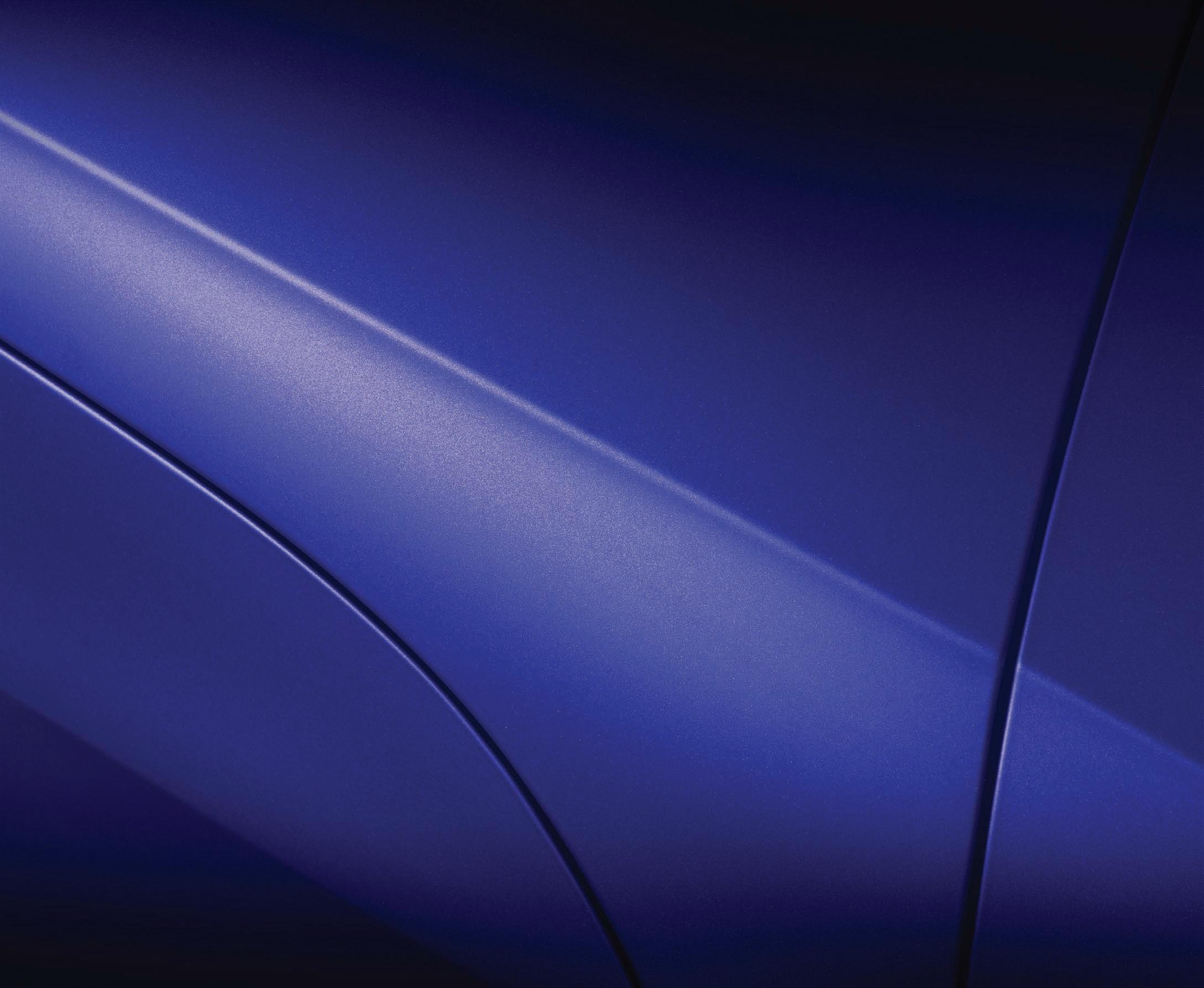

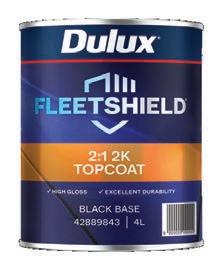
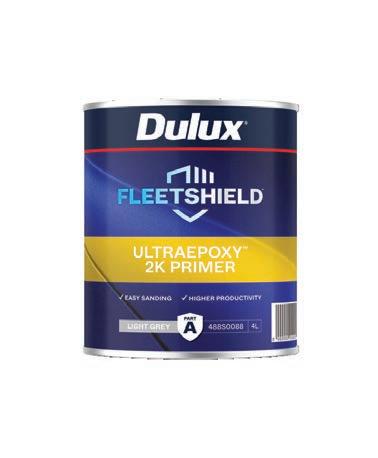
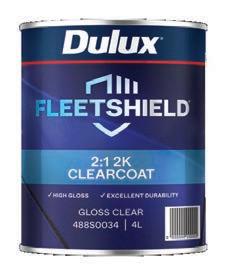



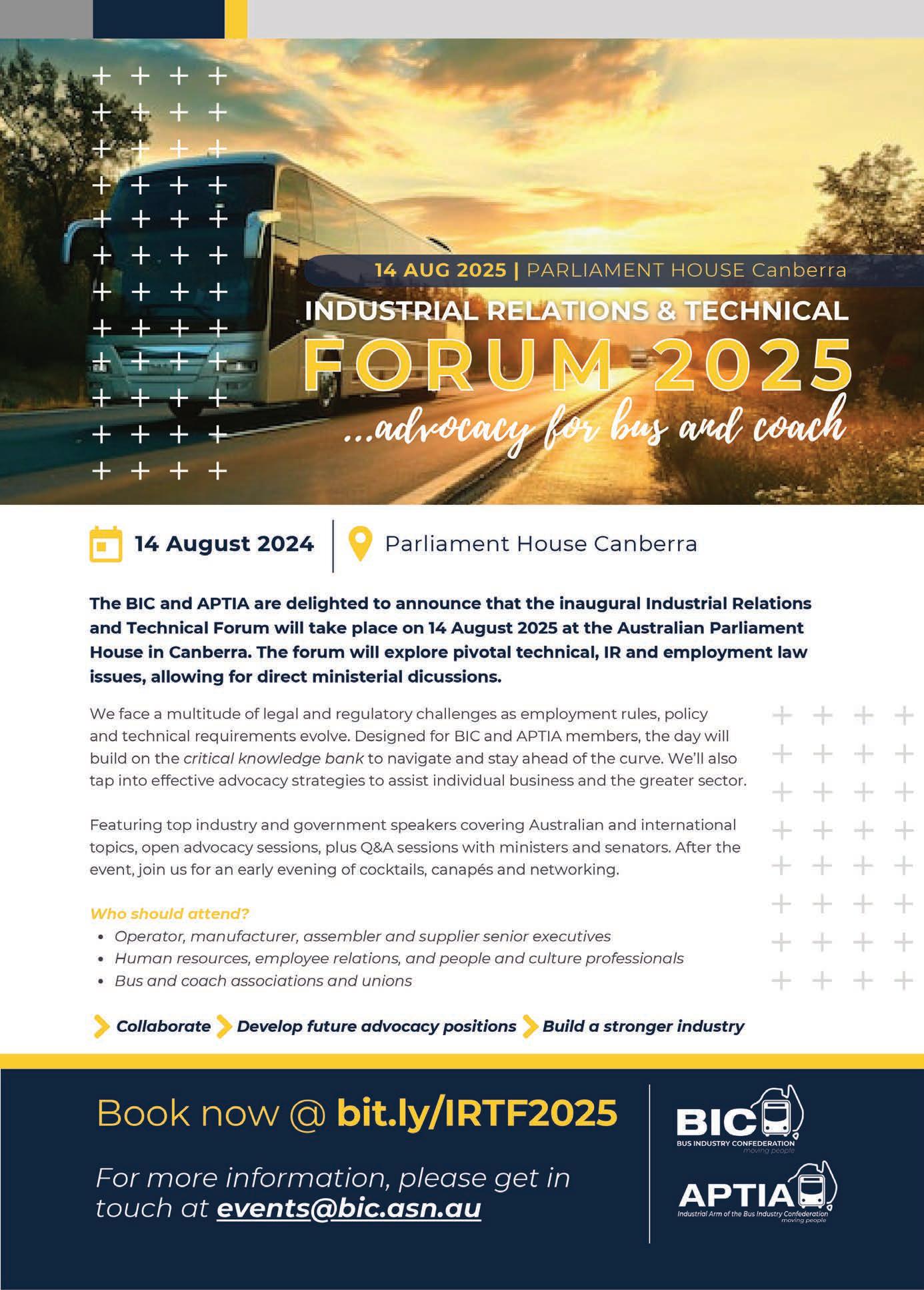



Sean Mortell sat down with BIC’s new executive director, Varenya Mohan-Ram, to learn about his upbringing, beliefs and goals to lead Australia’s bus industry into a new era
I’m roughly 10 minutes into my sitdown interview with Varenya Mohan-Ram when a keen member of the bus and coach industry comes to join us. It’s just minutes after Varenya had made his first speech to the industry since becoming the new executive director of the Bus Industry Confederation (BIC), calling for the packed Queensland Bus Industry Council (QBIC) annual conference crowd to unite.
As we venture into the need to remain focused before political parties to achieve growth for Australia’s bus industry, an attendee stops by to talk to the new BIC leader.
“I want to thank you,” he says while
shaking Verenya’s hand. “I want to thank you for taking the position, and I know you’re going to do a good job.”
For a person that I’m quick to learn is very well spoken and a deep thinker when it comes to tackling the collection of challenges facing the bus industry, Varenya is taken by surprise.
“That’s happened a lot today – more so than I expected,” he says while turning back to face me. Then, just like that, he’s back to talking about the intricate process of representing the industry in front of the decision-makers at Parliament House.
To understand the new face of Australia’s bus and coach industry, one has to first of all learn of his
unique upbringing.
Born on South America’s northern coast in British Guiana, a former British colony that is now known as the independent nation of Guyana, Varenya sees his beginnings as a reflection of many in the bus and coach industry.
“I didn’t start out with much,” he told ABC. “Born in British Guiana and it being a developing country, people didn’t have a lot there.
“The individuals in this industry reflect my own journey — starting with limited resources, persevering through challenges and achieving success through determination. Like many bus operators, I was told certain
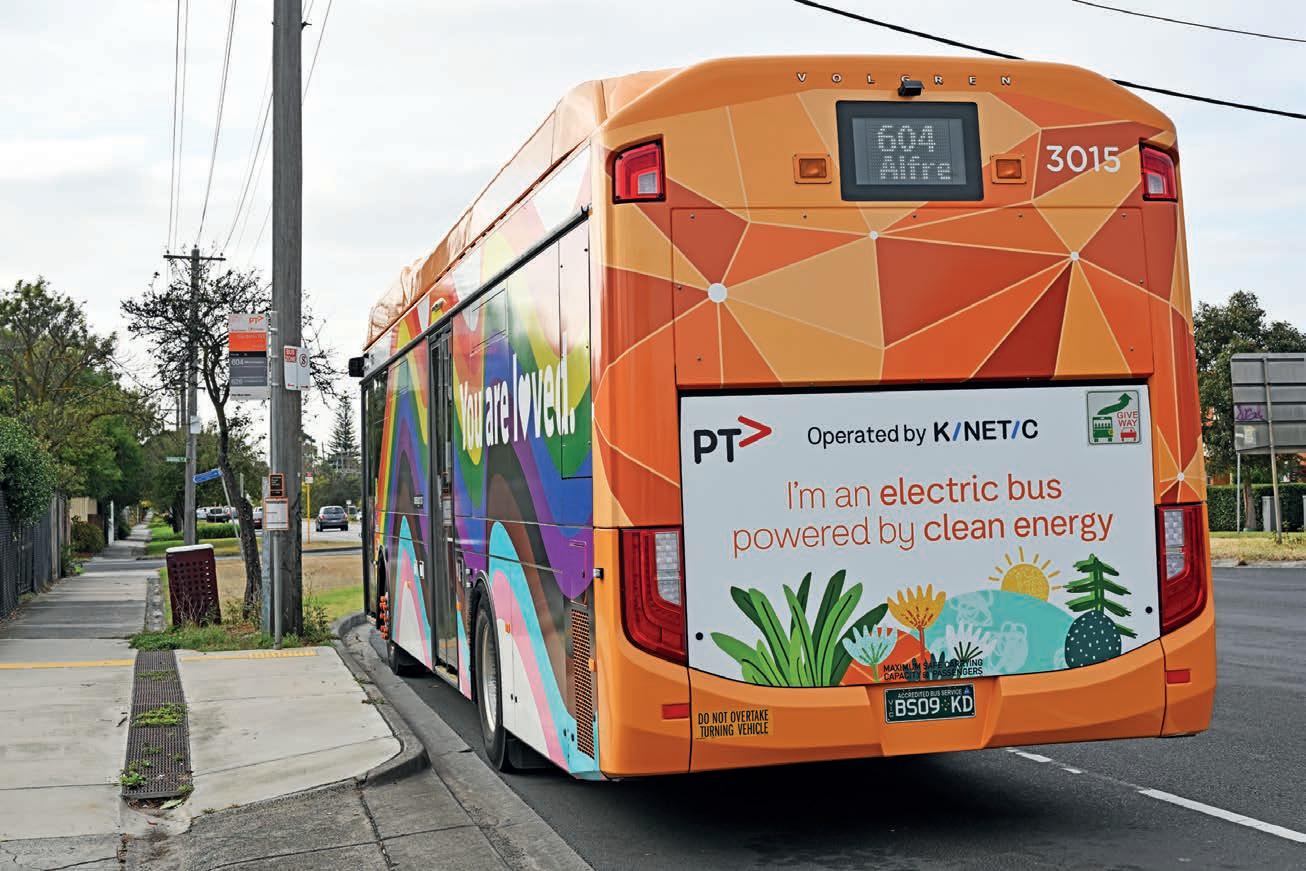
things couldn’t be done, but I relied on creativity and resilience to overcome those barriers and deliver results.”
When I catch up with Varenya, he is only a week into the role, but he’s well-known by many in the industry due to his previous work experience. While he brings more than 30 years of strategic management, government and cross-sector experience to the post, his most recent role as national business relationship manager at Team Super (formerly TWUSUPER Fund) has seen him cross paths with many in the industry.
It all started when he arrived in Australia from South America in 1987.
After completing school and a Bachelor of Science in Darwin, it was a part-time job that stoked Varenya’s passion for a career in unions.
“I worked at Kmart for eight years, eight months and eight days – it’s easy to remember,” he recalls. “While working at a large organisation, I realised that sometimes people can be forgotten and be treated as a number, and I felt something really wrong with that.”
When he was approached to be a delegate of the local Shop Distributive and Allied Employee’s Association (SDA), he jumped at the chance. He admits he “knew nothing about what it meant to be in a union”, but he was led by a belief that having a voice was important. It stoked the fire.
From there, Varenya rose to work for Rest Industry Super, representing the retail industry. Following this he was approached to take a role as the Labor Party secretary in the Northern Territory, meaning he was to join the ALP national executive and the political sphere as a whole.
These stepping stones resulted in Varenya becoming the national executive member of the ALP between 2011 and 2013 while heading up the NT branch as general secretary. He’s also been a member of various industry committees, standing on the boards of organisations like the Refrigerated Warehouse & Transport Association of Australia (RWTA), the Service Industry Training Advisory Council, Asthma Australia in the NT and the Association of Superannuation Funds of Australia
(ASFA), of which he was chairman in the NT.
Throw in a diploma of financial services in superannuation, a Master of Business Administration (MBA) and a Finance for Senior Executives from Harvard Business School, and it’s safe to say Varenya has well and truly made something of himself.
But what does all of this mean for Australia’s bus and coach industry? Varenya says he is looking to bring his experience and connections to the role to help the sector overcome present challenges and flourish.
“I don’t want to overstate my connections, but whatever relationships I have will be used to ensure every one of our issues is heard by every state, territory and federal government,” he says.
“It doesn’t mean we’re always going to like what politicians say, but we won’t back down from raising our issues because the bus industry matters and to do this I want 100 per cent unity to ensure politicians understand that we work with no disparate parts and that we are one.
“A united bus industry that advocates for the same things, such as a recruitment and retention plank, a need to look at the procurement process and the fact that local content needs a separate discussion, that will yield success. I’m excited, humbled and energised to be in this role.”
It may sound like a daunting target – how can one unite a whole nation’s industry and push it forward on the path of reform? Varenya’s first step as BIC’s executive director is to bring together the executive directors of every state and territory association.
“We need to have the same narrative – each state association does such good work, but we need to do it together,” he says.
“Currently all of our work is seeing one plus one equal two, but by uniting us under the one concise and consistent narrative, I believe we can make one plus one equal three and see the industry’s synergistic qualities yield success. It means the sum of our parts can produce more than us all trying to out-do each other.
“I’m not saying this has happened previously, but what I want is our synergistic qualities to bring the industry success.”
To achieve this, there’s an elephant in the room. In recent years, Australia’s various bus associations haven’t been united – the Bus Association of Victoria (BusVic) has not been a member of BIC, with last year’s National Bus & Coach Show being held in Brisbane instead of Melbourne like it was originally slated to be.
When mentioned, Varenya presented a constructive approach to re-forging bonds with BusVic and ensuring all states are onboard to work collectively with BIC and each other.
“Every state will need to work with BIC in a constructive manner, and that excludes no one,” he says.
“I’ll be seeking conversations with the EDS of bus associations – my relationships with each of these executive directors has pre-dated me taking this role, and I’ll be interested in constructive conversations.
“This is, after all, greater than me and any individual – it’s about the industry and ensuring that when we leave the roles we have, we leave it
better. That means we have to leave our egos at the door and ensure we’re thinking about all the stakeholders that we represent.”
The relationship between state associations may be set to change under Varenya’s rule, with BusVic also set to change hands this year. On June 30, long-time executive director Chris Lowe will resign, with Peter Kavanagh stepping into the role.
“I know Peter very well and the industry as a whole would like to congratulate him on taking the role while also thanking Chris for his time,” Varenya says.
“This new era with different voices gives us an opportunity to think about what we want for the industry. I’m sure every executive director in Australia wants to ensure that their legacy is about leaving the industry better off than how they received it, and I have no doubt that this will be the case with BusVic.”
To achieve this, Varenya says it all
work closely with Australia’s road freight sector due to the tendency for road freight to get in front of politicians more than other transport industries. His goal is to join with the road freight sector by combining certain key industry issues, such as the recruitment and retention obstacle, under the one banner to present to politicians.
“The other threat that we need to monitor closely is what the tariffs mean for our valued suppliers and whether it hurts our industry,” he says.
“It’s difficult to determine how much impact it’ll have on us when the USA has a fluctuating methodology that they’re applying to tariffs, but I want to help prepare for it.”
While the challenges come in abundance, Varenya is excited to tackle them with the help of the wider BIC group. The team, consisting of Andrea Luquesi-Scott, Lara Cole, Dean Moule, Glen Bortolin and Kirsten Jongsma, is one that Varenya speaks highly of, proudly emphasising
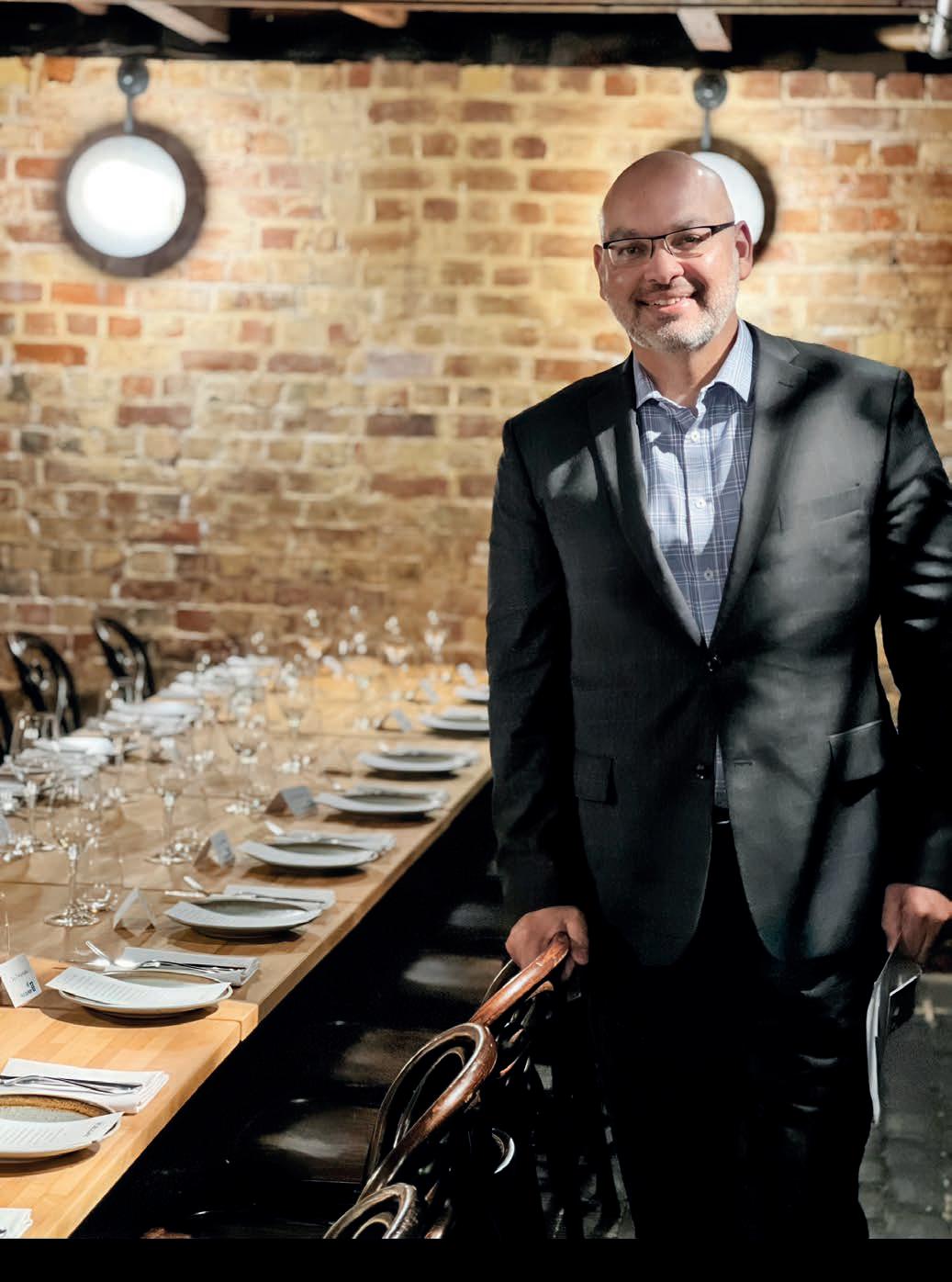
council and within its ranks makes him feel fortunate to be part of an association that is filled with “some of the most capable and knowledgeable individuals” he’s ever dealt with.
“This experience means BIC will take a position in some states with the consultation of the state EDs if the potential ramification of the issue is national,” he says.
“It doesn’t mean we’ll get everything we want as an industry, but we won’t take a backwards step in reminding governments of all persuasions that this is the best industry to connect Australians in the most cost-effective way.”
A national approach is quickly set to be determined for the zero-emissions transition. For years, the local industry has been leading the way in the transport sphere when it comes to the sustainable switch, but it has done so with limited political and legislative guidance. Now, seeing overseas examples, such as in the US where
the Donald Trump administration has switched to veer away from zero-emissions vehicle technology, Varenya knows he has a rocky patch ahead of him.
“This really sends a global message that rocks the world to its core because there’s no similarity in the message that allows our suppliers, manufacturers, assemblers and importers to set their agendas and budgets accordingly,” he says.
“In Australia we see one side of politics wanting the zero-emissions policies and outcomes, while the other side doesn’t want to engage in the discussion and, unfortunately, it’s not a good strategy for the bus industry.
“Whatever decisions are made in Australia, our suppliers need surety and continuity. It rests on us as the thought leaders to work with both sides of politics to begin this conversation in a strategic way.”
As we meander towards the end
of this hour-long chat that covers all topics and challenges currently before Australia’s bus and coach industry, Varenya works his way to a clear message that he wants everyone to know. While he may be in the opening months of his post at BIC, he reiterates that working together will bring the best out of all parts of the industry.
“The one message I want to give to every person and company in the bus industry is to join your associations,” he says.
“We can do more as a group representing and advocating to government than we can separately, so let’s make our unity a strength in this ever-changing environment.
“It will allow us to do our best work but also to allow BIC to strategically speak on behalf of the industry. It’s through this method that we can achieve the best results for an industry that so richly deserves representation.”


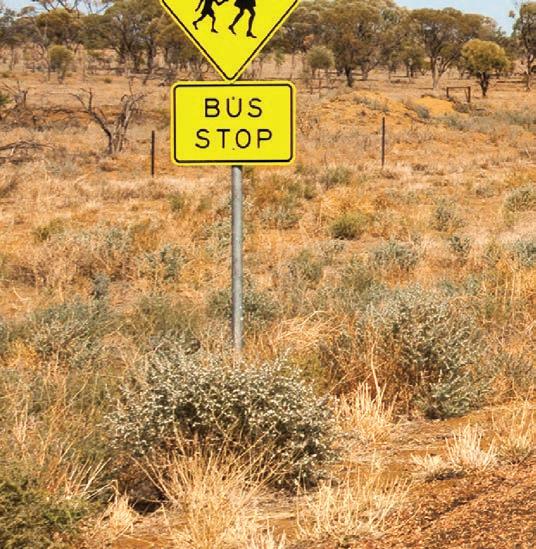



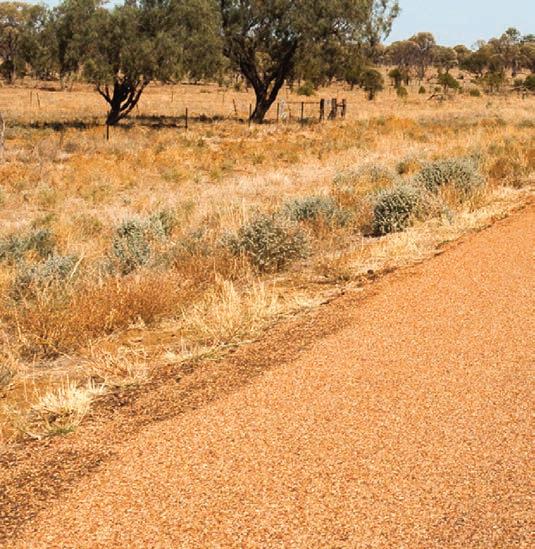








With
Sege Seats and Irizar working hand-in-hand, the partnership is redefining comfort and safety in the bus and coach industry
When you step onto a bus or coach, you might not think twice about the seat beneath you. But behind every well-cushioned ride is a carefully engineered partnership that makes it possible.
In the case of Sege Seats, its partnership with Irizar Asia Pacific is one that’s quietly reshaping how comfort, safety and innovation come together on wheels.
What started as a single collaboration in 2018 has evolved into one of the most trusted and collaborative relationships in the local
bus and coach sector.
Today, Irizar and Sege are not only delivering seating solutions across school, charter, and luxury transport, they’re showing the rest of the industry what’s possible when two companies share a vision.
“The partnership between Irizar and Sege Seats began in late 2018, marked by our first collaboration on seat supply for Greyhound buses,”
Irizar sales and marketing manager Laoana Mendes told ABC
“This initial engagement laid the foundation for a strong relationship, which quickly extended to other operators purchasing Irizar school
Above: Safety is a shared priority for both Sege Seats and Irizar and is central to their ongoing collaboration
buses with Sege seats as the standard fitment.”
According to Irizar, the choice to work with Sege was no accident. The seating company ticked all the right boxes from the beginning.
“Our decision to partner with Sege Seats was driven by their flexibility, commitment to quality, and responsiveness to customer needs,” Mendes says.
“Sege demonstrated a strong ability to customise seat designs and colours to suit individual operator requirements – an essential factor that aligns closely with Irizar’s philosophy of delivering tailored solutions

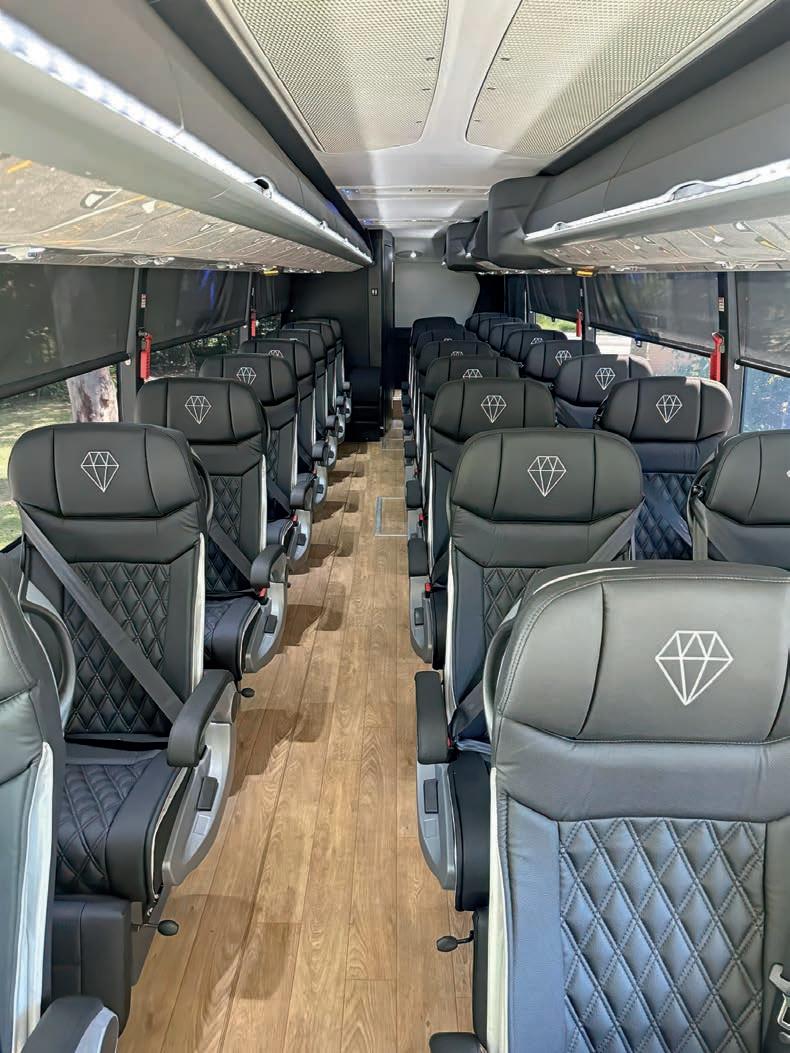
Safety is a shared priority for both companies and is central to their ongoing collaboration.
“Sege plays an important role in supporting Irizar’s objectives for comfort and safety,” Mendes says.
“Their seats are ergonomically designed and fully compliant with both Australian Design Rules (ADR 68) and European ECE safety standards. This ensures our passengers benefit from a safe, comfortable ride –consistent with Irizar’s reputation for quality and reliability.”
Optional features like USB ports, tray tables, magazine nets, and footrests can be added for enhanced comfort and convenience. Operators can also specify foam density, ergonomic shaping, and other modern amenities.
“It’s all about giving operators the ability to design for their customers,” Taskin says.
“We make sure the seating fits the service, not the other way around.”
From daily school routes to luxury interstate trips, Sege delivers versatility and modern features that support Irizar’s wide product offering.
The two companies collaborate to align seat designs with Irizar’s vehicle specifications, branding, and passenger experience goals.
working together to update and enhance seating solutions to meet the evolving requirements of ADR 68.
Irizar also regularly shares customer
feedback with Sege to inform product improvements, ensuring that vehicles continue to meet and exceed passenger expectations.
“Every seat we produce is engineered with safety at its core. It’s not just about meeting regulations, it’s about giving passengers and operators real confidence that they’re protected,” Taskin says.
“Working with Irizar means we can align our designs with their safety goals from the start. It’s a partnership where safety is expected at every turn.”
Beyond product innovation, the strength of the pair’s relationship reflects the long-term value of supplier collaboration in an industry driven by service quality and customer satisfaction.
“We see our relationship with Sege continuing to grow stronger in the years ahead,” Mendes says.
“As Irizar expands in Australia and across the Asia-Pacific region, we look forward to deepening our collaboration, co-developing solutions, and driving innovation that supports the evolving needs of our customers and the industry.”
For Sege, being part of that journey is a point of pride.
“Our job is to support OEM’s like Irizar in delivering vehicles that make a difference for operators, drivers,

With major changes coming for the Australian bus and coach industry, Tiarna Condren finds out how StyleRide is stepping up to the plate
As the bus and coach industry continues to evolve under the pressure of regulatory shifts, sustainability goals and the transition to electric vehicles, seat manufacturer StyleRide is embracing the challenges with confidence.
One of the most immediate changes facing the sector is the introduction of a new Australian Design Rule (ADR) that will require buses and coaches to feature seatbelt wearing monitoring technology and mandatory signage.
All seating positions, excluding the driver’s seat, are required to have signage indicating the necessity of wearing seatbelts, focused on increasing seatbelt usage among passengers. For StyleRide, this hasn’t posed a significant hurdle.
“There’s no issue for us, because it’s quite a simple fix,” StyleRide national business development manager Troy Wells told ABC
“We have ensured that all our products have met certain requirements before, and this is no different. We’re prepared for it and have set ourselves up for it.”
Beyond the rear-seat labels, minor alterations may be required for modesty panels at the front of the vehicle, which will involve collaboration with bodybuilders.
“That’s the only discussion we’ll have to have with our partners, about what happens at the modesty panel for the front seats. But every other seat will have it,” he says.
The industry’s shift towards electric and hydrogen-powered buses is also driving new conversations around weight reduction. Recognising the importance of lighter builds to improve energy efficiency, StyleRide is proactively refining its product offerings.
“We’re always looking at ways to
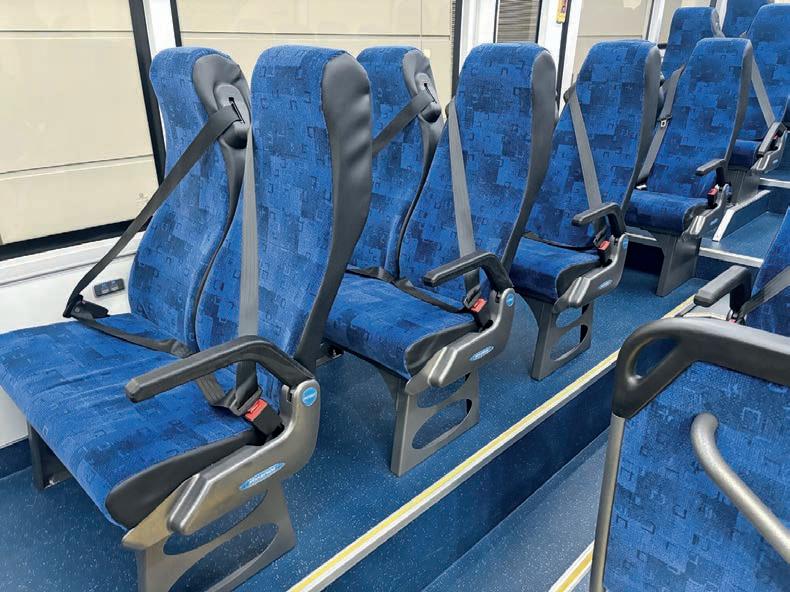
a lightweight seat.
“The current product range is fairly light in comparison with others in the market, and so for the time being we haven’t had to make many changes.”
While current demand hasn’t heavily shifted due to the dominance of electric buses in metro fleets, StyleRide’s existing metro products already cater well to these needs.
“Our metro product is actually well suited to that market,” he says.
“Once more coach and school buses are heading the electric route, we will be the first to sit down with customers and figure out the best seating solutions for them.
“It’s something we believe will get more attention.”
While adapting to the needs of the broader industry is a priority for the brand, passenger comfort and customisation remain at the heart of StyleRide’s design ethos. With ongoing feedback loops and close collaboration with customers, product development is continuous.
“We’re always listening. I go out to visit customers and say, ‘What do you
This mindset also applies to StyleRide’s operations, particularly when it comes to improving sustainability and reducing its environmental impact.
“Along with our suppliers, we’re always trying to find better ways to do things,” Wells says.
“We’ve streamlined procedures in our factory to reduce production time, and all of that has an environmental benefit.”
The key to the bus and coach industry and the continued success of the StyleRide brand Wells says, is Australian manufacturing.
“We have to keep that strong. Yes, imported vehicles play a role, but local production is vital,” he says.
“That is the one thing that I wouldn’t want to see change in the industry.”
Looking ahead, StyleRide sees opportunity in staying true to its customer-first approach.
“Passengers have got to put their bum somewhere, so let’s make sure our product is the best product out there.”
Battery manufacturer CATL says these new innovations will lead the industry into the “multi-power era”
CATL has launched three revolutionary EV battery products at its first Super Tech Day in the Freevoy Dual-Power Battery, the Naxtra sodium-ion battery and the second-generation Shenxing Superfast Charging Battery.
The Naxtra Battery is the world’s first mass-produced sodium-ion battery, offering an energy density of 175Wh/kg, a 500km range and over 10,000 cycles. Notably, it operates from -40°C to 70°C, retaining 90 per cent power at extreme cold, and offers intrinsic safety by eliminating combustion risks. Naxtra’s 24V version for heavy-duty trucks reduces lifecycle costs by 61 per
cent compared to lead-acid batteries and delivers reliable cold-weather performance.
The Freevoy Dual-Power Battery introduces a cross-chemistry system with dual independent energy zones, enabling tailored power delivery based on driving habits and conditions. It supports five dual-function capabilities, including dual thermal management and safety protections. With self-forming anode technology, it boosts volumetric energy density by 60 per cent, enabling ultra-long-range vehicles. Configurations include Sodium-LFP for cold climates, LFP-LFP for cost
efficiency and NCM-LFP/NCM-NCM for ultra-high power and ranges beyond 1,500kms.
The Second-Generation Shenxing Superfast Charging Battery sets a new benchmark as the world’s first LFP battery with both an 800 km range and 12C peak charging rate. It delivers 2.5 km of range per second and charges from five per cent to 80 per cent in just 15 minutes, even at -10°C.
These innovations mark a shift from parameter-driven to demand-driven battery design, powering a more flexible and user-centric future for EVs, commercial vehicles and renewable energy systems.


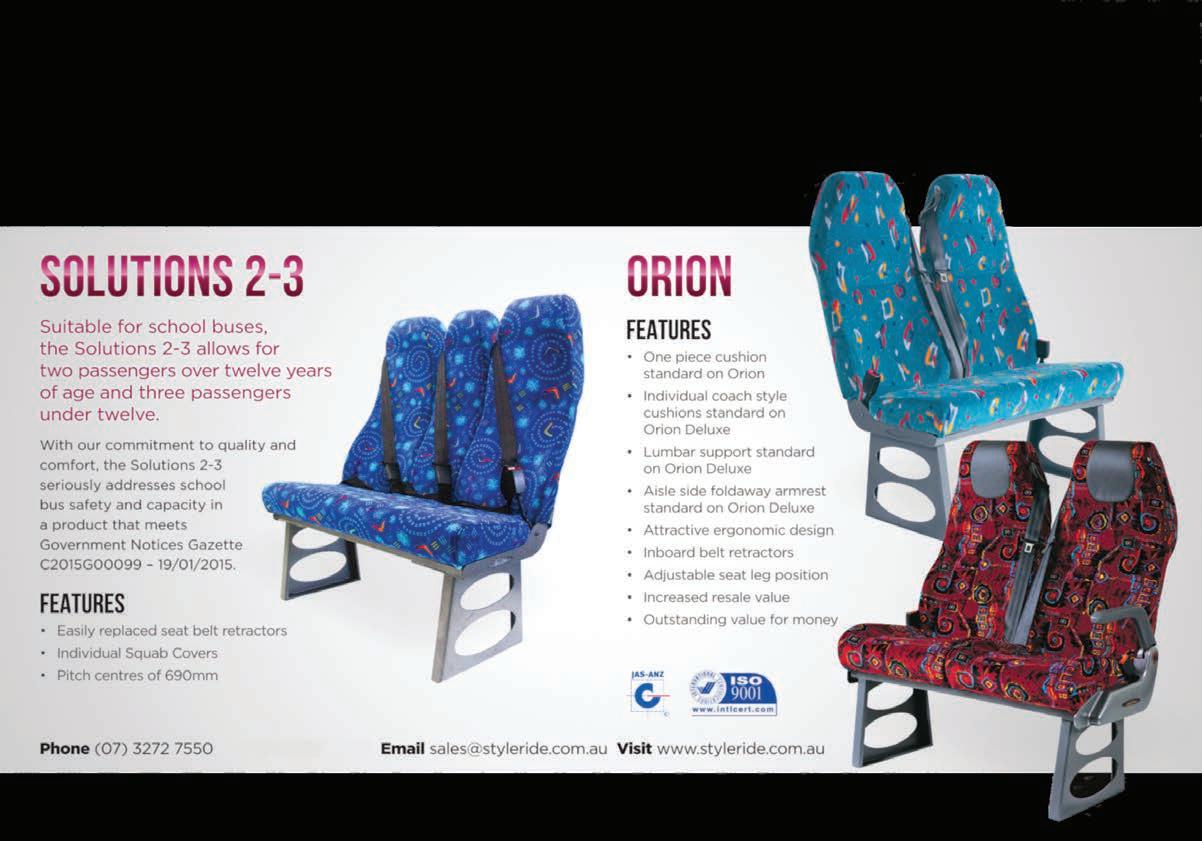

out how local partnerships like these are keeping the industry thriving
When McConnell Seats first swapped scissors for automated cutters, the company wasn’t just upgrading equipment but laying the foundation for a strong Victorian manufacturing partnership.
Two decades later, McConnell and Pathfinder Cutting Technology are still moving together, adapting to an industry where speed, accuracy, and local capability are more critical than ever.
“The relationship began back in 2005, when Pathfinder’s founder John Hollo dropped into McConnell Seats and introduced himself to Dennis McConnell and Alan Smith,” Pathfinder sales manager Wayne Walker told ABC
“At that time, McConnell’s upholstery cutting process was still
largely analogue, using hand-cut templates and scissors.
“Denis and Alan quickly recognised that investing in digital technology was essential for the future, and within just a few months, Pathfinder installed a CAD system and a K-Series CNC cutting machine.”
In the twenty years since, that decision has paid dividends.
Thousands of buses and coaches across Australia have been fitted with McConnell’s expertly crafted seating, with fabrics precision-cut on Pathfinder’s technology.
But technology, like the industry itself, never stands still.
Now, McConnell Seats is ushering in a new era with the installation of the latest Pathfinder M-Series system, complete with the advanced FabricPro automatic material spreader.
Above:
The latest Pathfinder M-Series system, complete with the advanced FabricPro automatic material spreader.
Image: Pathfinder
“The new system is a major leap forward,” McConnell Australia general manager James Lowe told ABC
“It’s faster, it’s smarter, and it’s more sustainable. It allows us to maximise material efficiency, reduce waste, and keep production moving without relying heavily on skilled manual labour, which is becoming harder to find.”
The M-Series was designed around a few critical principles: ease of use, minimal maintenance, productive engineering, and safety. This new technology not only improves cutting precision and production speed but also helps digitise workflows, providing McConnell with better data for planning, scheduling, and training.
“In today’s world, you can’t afford to stand still. You either innovate or you get left behind,” Walker says.
“No one’s rushing back to the horse

and cart anytime soon, and the same is true for manufacturing methods.”
The McConnell/Pathfinder partnership is a shining example of the power of local collaboration, something that’s vital for Victoria’s manufacturing sector.
“Strong local partnerships are the backbone of a resilient manufacturing economy,” Lowe says.
“By sourcing materials, technology, and expertise locally, you’re not just creating jobs, you’re strengthening communities and building capabilities that are essential for long-term prosperity.”
This local-first philosophy has tangible benefits. Pathfinder manufactures its machines and software right here in Victoria, working with over 200 local suppliers. McConnell, in turn, benefits from immediate access to service, support, and innovation, a stark contrast to the long lead times and uncertainties that can plague companies reliant on overseas supply chains.
“It’s not just about dollars and cents but about building an industry that can sustain itself and compete on the world stage,” Lowe says.
“Around 80 per cent of our supply chain is based in Victoria. It is critical for us, and the people we work with, that those relationships remain.”

Volgren are a key customer of McConnell’s, forming part of that critical supply chain. Lowe says the flow on effect from the bus body manufacturer and other OEM’s is felt down the line.
“If the volume of orders is reduced through Volgren, it will impact McConnell and numerous other businesses through the rest of the chain,” he says.
“That is why it’s essential to keep the Victorian bus and coach industry alive and thriving.”
After decades of offshoring and underinvestment, Walker says it’s clear the industry needs to maintain strong sovereign manufacturing capabilities, not just for economic prosperity, but for national resilience.
“We’re proud that our machines, built right here in Melbourne, are running in some of the world’s most advanced manufacturing facilities,” Walker says.
“It’s proof that Australia still makes world-class products. You just have to know where to look.
“Whenever possible, we believe it’s better to partner locally. If more companies understood the full economic and social impact of keeping supply chains and money local, we’d have even stronger communities and industries.”
Alongside its technology upgrades, McConnell Seats is also leading the way in adapting to new Australian safety regulations. McConnell are updating its seating offerings to comply with the updated seat belt Australian Design Rules (ADRs).
In new buses and coaches, visual and audible alerts will be introduced to encourage seatbelt usage. A label must also be sewn on each seat back and modesty panel reading “Fasten seat belts while seated”.
“Working with operators allows us to combine practical fleet experience with our manufacturing expertise,” Lowe says.
“We’re designing seating solutions that are safer, more durable, and aligned with the future needs of operators.”
This new project not only strengthens McConnell’s product offering but also reinforces its commitment to supporting the evolving needs of the Australian bus and coach industry.
As standards continue to rise, McConnell is positioning itself as a key partner for operators who demand quality and local manufacturing support.

Tiarna Condren speaks to the Bus Industry Confederation about how to better protect bus drivers against a recent rise in anti-social behaviour onboard services
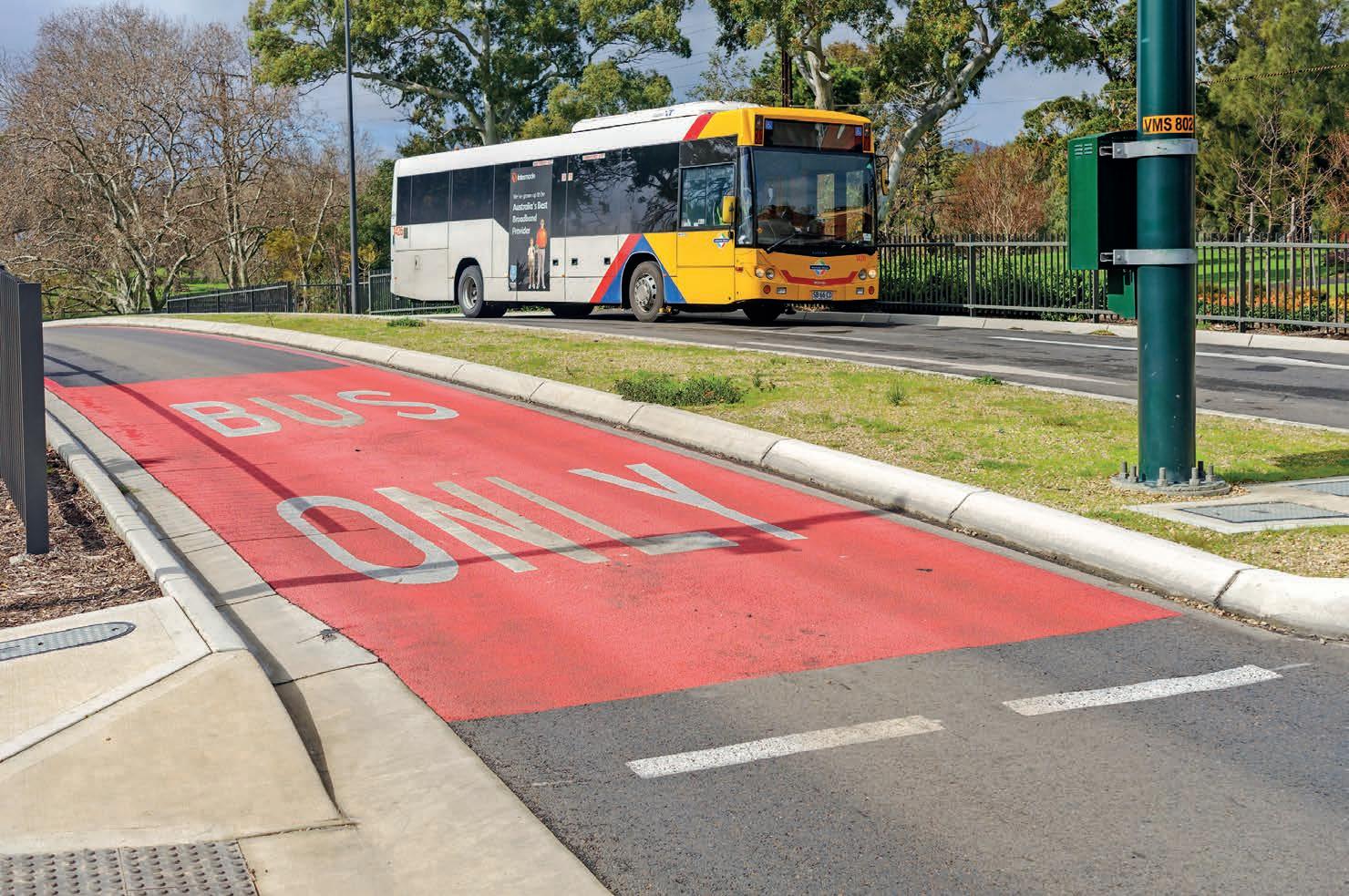
Across Australia, bus drivers and passengers alike are grappling with the troubling trend of anti-social behaviour and assaults on buses.
Once considered relatively safe spaces for commuting and community interaction, buses have increasingly become the scene of verbal abuse, physical threats and even violent attacks.
For many drivers, going to work now means bracing for potential confrontation. It’s a daily reality that weighs heavily, especially for those operating late-night or suburban routes.
In cities like Sydney, Melbourne and Brisbane, public transport unions report growing concerns from their members. Data from Transport for NSW shows that reports of physical attacks on public transport have risen more than 80 per cent between 2022 and 2024, with buses accounting for a significant portion.
Verbal abuse has skyrocketed, rising over 184 per cent in the same period, while physical threats have increased 85 per cent.
Assaults on drivers and fellow passengers are becoming more frequent, often triggered by minor disputes such as fare evasion, overcrowding, service delays
Above: BIC has outlined two specific measures that it believes can stem the rise of anti-social behaviour. Image: myphotobank.com. au/stock.adobe.com
or intoxication.
Bus Industry Confederation (BIC) national technical manager Dean Moule told ABC the continual steady rise in anti-social behaviour is a significant issue for society, and public transport is a “soft target”.
“Even with extensive onboard CCTV systems and driver de-escalation training, our industry still sees alarming increases in driver assaults – in most cases doubling over the past five years,” Moule says.
“Bus drivers are the backbone of our industry, providing an essential service and transporting 40 per cent of Australians to their destination every day. However, they don’t
benefit from the same protections as essential workers, which set robust deterrents for offenders and make drivers feel safer.
“No one should feel unsafe in their workplace.”
In a submission to the parliamentary inquiry on Options for Essential Worker Housing in New South Wales last year, the Transport Workers’ Union (TWU) urged the NSW government to broaden its definition of essential workers to include those in critical transport sectors like buses, waste management and road freight.
Under the state government’s current definition of essential workers, only employees from health, education, police, fire and rescue and justice are included.

is cause for urgent improvement,” Moule says.
Moule says other states should follow the Northern Territory’s lead after the jurisdiction introduced new legislation in October last year that protects bus drivers by ensuring minimum mandatory sentences for cowardly assaults on front line workers.
Efforts to combat anti-social behaviour on buses are primarily driven by state and territory governments. In response, transport authorities and unions are pushing for a multi-pronged approach to address the problem. One key measure is the installation of more surveillance cameras, panic buttons and protective barriers around drivers.
Recently, South Australia has installed approximately 940 protective screens on Adelaide Metro buses to shield drivers from violent and unruly passengers. While the screens were anticipated to be installed in all Adelaide Metro buses over the next four years, the SA government announced the initiative has been fast-tracked, with network-wide installation now set for completion before the end of 2026.
While this is a step in the right direction, Moule says implementing these screens across the country is proving to be a difficult process.
“Fitting full driver screens to provide physical barriers against physical attacks is possible, however, the regulatory process to fit them is slow and unnecessarily expensive. This
“BIC, along with key stakeholder members, has been working with the National Heavy Vehicle Regulator (NHVR) to better refine the screen fitting process.”
Tasmania’s Metro bus drivers are the most recent to receive the added protection, with the $2.1 million safety screen project receiving a first-of-itskind exemption to ensure theensure the screen’s design meets strict safety standards and can be installed in buses before the national safety standards are finalised.
“The BIC is near to releasing a guide geared to simplifying and standardising the fitting of screens.
This member-led endeavour is at the global forefront of driver protection and, yet again, highlights the industry
solving industry issues,” Moule says.
While other states have implemented its own campaigns and protections, such as Victoria Police’s STOPIT service, Dean and BIC believe more can be done to protect staff and passengers.
“The BIC believes that the following two measures will go a long way to stemming the rise of assaults, beyond being deterrents and physical protection, as no single action can be a solution,” he says.
“The re-elected federal government must work with industry to fast-track and simplify pathways for vehicle screen fitting.
“State and territory governments must reclassify bus drivers as essential workers or set tougher penalties as a matter of highest importance.
“The time for action is right now.”
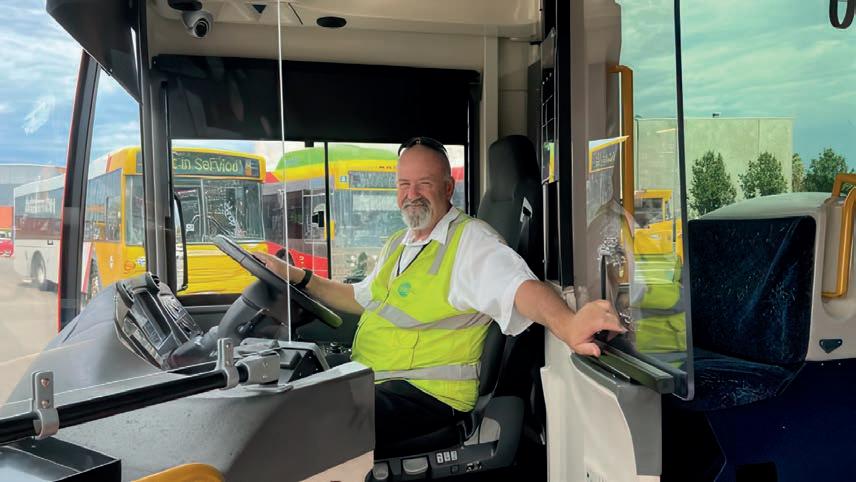
Ventura Systems’ advanced door technology is playing a large part in Brisbane’s recent public transport transformation
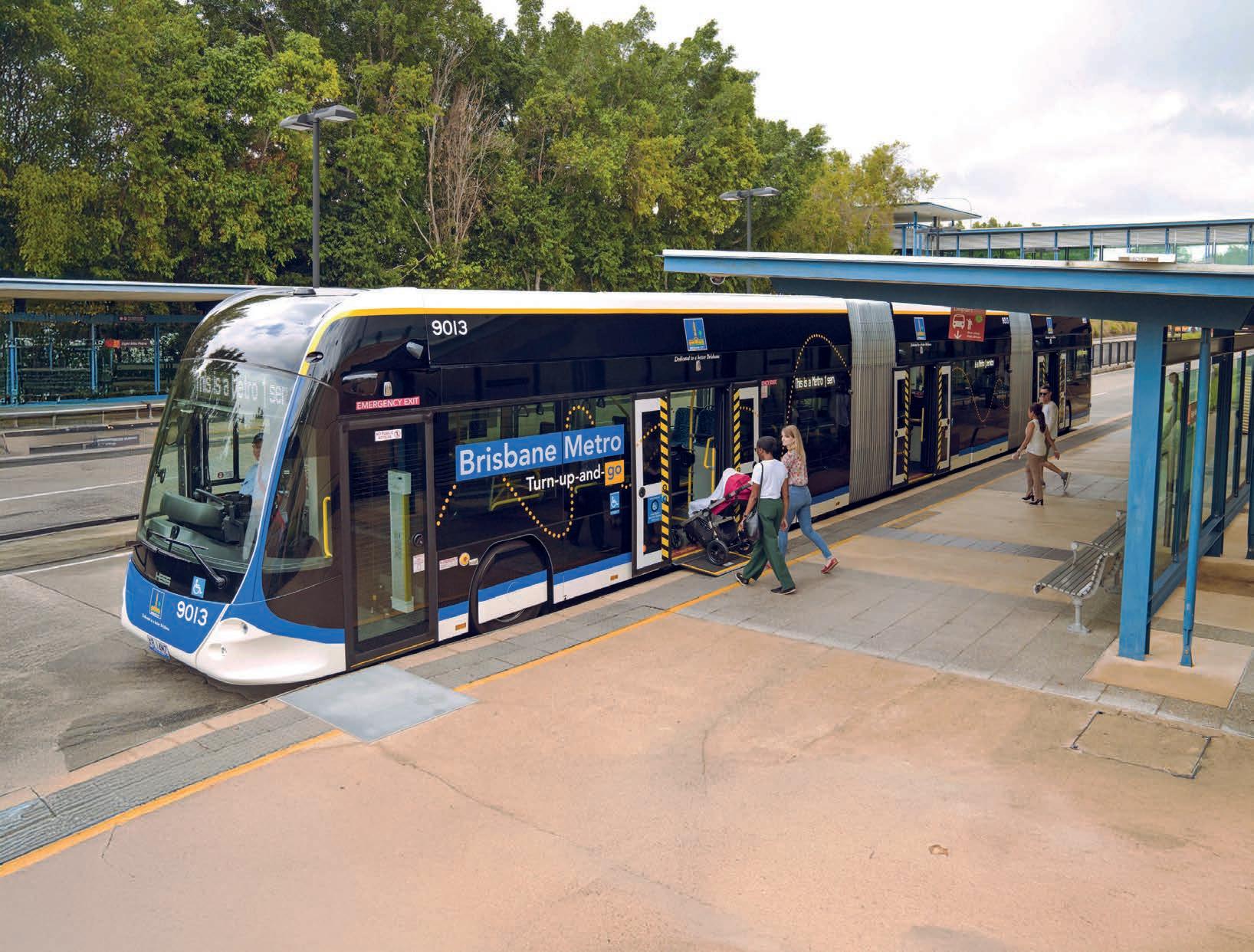
Brisbane is one of Australia’s fastest-growing cities, and with more than two-thirds of public transport users travelling by bus, Brisbane City Council is introducing Brisbane Metro Bus Rapid Transit (BRT) services. With a new fleet of high-capacity, high-frequency turn-up-and-go electric metro vehicles, Council is meeting the growing demand for fast and reliable ways to travel.
Operating on Brisbane’s busways, the metros move more people, more often, transforming urban mobility by delivering two dedicated routes (M1 and M2) that provide fast, frequent and reliable turn-up-and-go services. Council has worked closely with Swiss bus manufacturer HESS to design the metro fleet using the lighTram®25 model as the base design and completing extensive local testing to deliver a vehicle that is built for Brisbane.
With a spacious 24.5 metre bi-articulated design, each metro can transport up to 170 passengers, using
three large double doors. The door system, supplied by Ventura Systems, plays a crucial role in delivering safe and efficient all-door boarding. The M1 and M2 routes connect some of Brisbane’s busiest busway stations and the boarding experience is crucial to ensure both customer safety and service reliability is maintained to the highest standard.
The launch of metro services marks the beginning of transforming the way people move across Brisbane. The early success of Brisbane Metro has resulted in a $50 million business case to explore the expansion of metro routes across Brisbane.
The challenge for any mass transit system lies in efficiently transporting high volumes of passengers with frequent stops and short intervals while ensuring equal accessibility for all passengers. The metro design reflects its ability to handle high passenger volumes, particularly through its door system configuration.
“Unlike many conventional buses,
Above: Ventura’s advanced door systems remain a critical component in moving Brisbane forward
metros feature outward-opening doors rather than inward-gliding doors,” Ventura Systems Australia and New Zealand general manager Wolter Meijerhof told ABC
“At the front, a unique rapid sliding door system serves as a dedicated entrance for the driver’s compartment. By moving outward, it maximises interior space and offers better sealing compared to an inward-gliding door system.”
To facilitate efficient passenger boarding and alighting, three wide plug sliding door systems have been installed, ensuring completely unobstructed doorways. Unlike inward-swinging doors, plug sliding doors do not take up interior space or obstruct passengers waiting to exit. This makes them ideal for all-door boarding, significantly reducing dwell times.
“For passengers with accessibility requirements, the first plug sliding door system is integrated with an electric ramp from a third-party supplier, designed to function

seamlessly with the door system,” Meijerhof says.
“For customers that are able to, pressing the ramp request button activates the request for automated ramps to be deployed by the metro operator and opens the doors accordingly.
“The additional interior space created by the door system configuration gives designers greater flexibility to enhance accessibility and optimise seating arrangements.”
Passenger safety and comfort was prioritised when designing the metro fleet, with the first customer touchpoint being the doors. Each door system is equipped with a sensitive edge as well as obstruction detection that prevents the doors from closing while passengers are boarding or alighting.
If the edge or the obstruction detection sensor detects movement, the doors automatically reopen. The sensitive edge and obstruction detection remains active during door operation to alert the driver of any activity that may require attention.
The door control unit serves as the system’s central intelligence, enhancing safety through preset parameters and ensuring a secure journey for all passengers.
The door system is electric, replacing older pneumatic technology. While a minimal amount of compressed air is required for the emergency system, the doors operate entirely
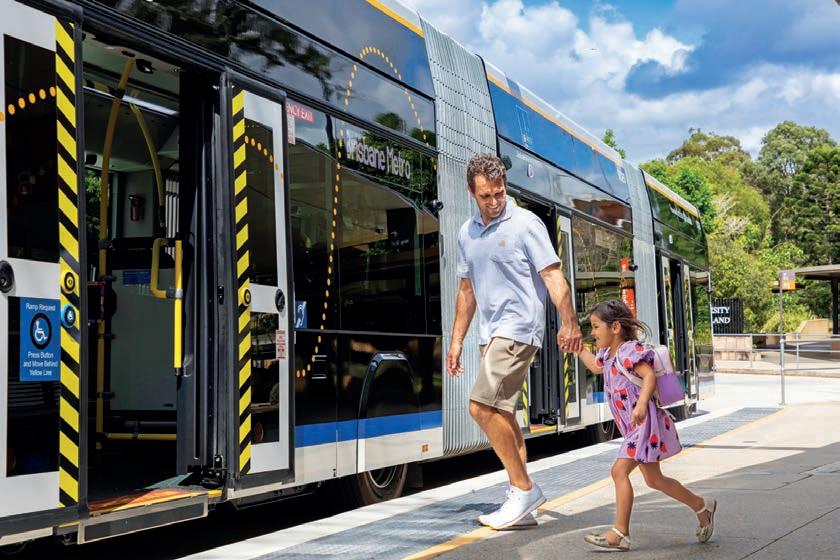
movement forces, enhancing drivetrain durability and minimising wear.
Additionally, electric door systems require fewer adjustments during operation, as they are less affected by variations in compressed air quality. They are also quieter and more energy-efficient, benefiting both passengers and operators.
“The design of the vehicle and door systems addresses not only the challenges of public transport but also the demands of Brisbane’s unique climate,” Meijerhof says.
“Unlike typical urban environments, Brisbane’s weather conditions directly influence the configuration of the door systems and overall vehicle design.”
High temperatures and prolonged sun exposure can lead to material expansion and increased wear
Above: Passenger safety and comfort was prioritised when
components while high humidity can lead to condensation, potentially affecting electrical components.
Frequent heavy rainfall requires effective sealing to prevent water ingress. Brisbane experiences severe summer storms with strong winds, which can put additional pressure on door mechanisms. Coastal winds can carry salt and fine dust, leading to corrosion and increased maintenance requirements.
“To ensure reliable operation in Brisbane’s demanding climate, Ventura Systems’ door solutions are engineered with durability, safety and efficiency in mind,” Meijerhof says.
Below:
The door system for the new Metros are electric, replacing
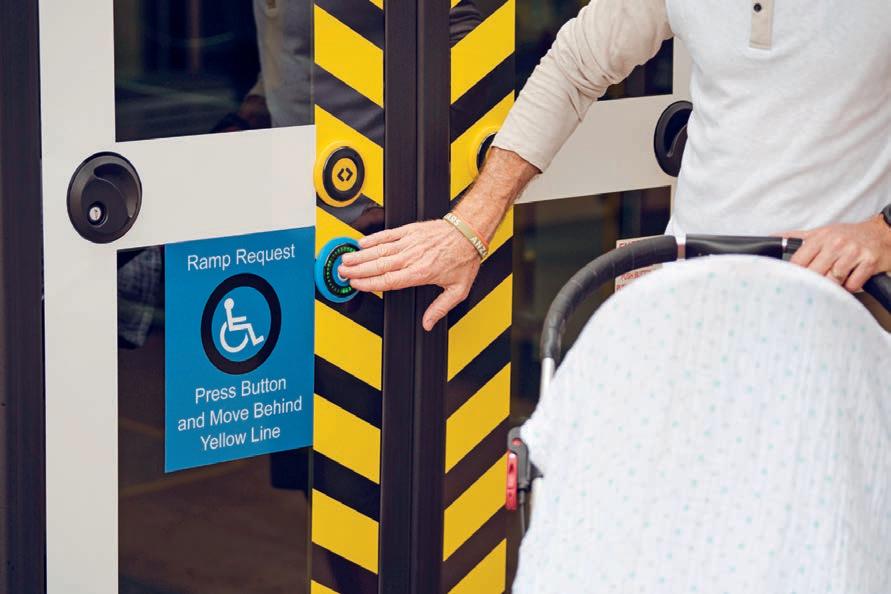
“Drawing from extensive experience in global markets with similar environmental challenges, the door systems incorporate advanced materials, intelligent design and rigorous testing to withstand extreme temperatures, humidity, heavy rainfall and coastal exposure.”
Brisbane Metro is just the beginning of a new era of bus rapid transit mobility: one that prioritises efficiency, sustainability and an enhanced passenger experience. With future expansions set to move even more passengers each year, the city is embracing a smarter, more connected future.
As Brisbane Metro continues to evolve, so too will the technology behind it. With each new stage, Ventura’s advanced door systems will remain a critical component in moving the city forward – one safe and efficient journey at a time.
Nominations for the 2025 Endeavour Awards are now open, including the addition of an innovation in transport award
Nominations are now open for the 2025 Endeavour Awards, with transport manufacturers included for the first time in this year’s program.
The 2025 program will see an innovation in transport award added for bus and coach manufacturers to check out.
The essential requirement to nominate for the Endeavour Awards is to have an element of manufacturing in Australia present in your operations.
The innovation in transport award is for businesses enhancing vehicle manufacturing, public transport or sustainable mobility solutions.
Eligible innovations must be new to market or have made advancements within the two years prior to the nominations closing date.

To nominate, businesses will have to demonstrate how their manufacturing innovations has improved the industry when it comes to environment and sustainability, productivity, efficiency and speed, cost-saving or safety. Nominations must be completed online by Thursday October 2 this year at 11.59pm.
Outside of the transport award, other award categories for 2025
include technology application, outstanding start-up, innovation in health technology, innovation in aerospace and innovation in food and manufacturing.
To find out more about the Endeavour Awards and the innovation in transport award, head to: endeavourawards.com. au/nominations.
MAY
MAY 30-31
TasBus Annual Conference
JUNE
JUNE 01
TasBus Conference
JUNE 14
QBIC Regional Forum – Gympie
JUNE 15-18
UITP Summit
JULY
JUNE 11
QBIC Future Leaders Luncheon
JULY 18
BusWA BCI Bus Show
AUGUST
AUGUST 2
QBIC Regional Forum – Chinchilla
AUGUST 22
BusNSW NextGen Leaders Forum
SEPTEMBER
SEPTEMBER 11
QBIC Regional Forum – Gold Coast
SEPTEMBER 15-17
BCA Conference
OCTOBER
OCTOBER 1-2
BusNSW Member Conference
OCTOBER 4–9
Busworld Europe
OCTOBER 22
PTAANZ Annual Conference and Gala Dinner – Brisbane
OCTOBER 29-31
BIC National Conference – Perth
NOVEMBER
NOVEMBER 14–15
QBIC Regional and Partner Forum – Cairns
NOVEMBER 21
BusNSW Platinum and Gold Partners Luncheon
NOVEMBER 22
QBIC Christmas Function
DECEMBER
DECEMBER 1
BusNSW Xmas Function
With decades of experience and a commitment to quality, McNaughtans continues to supply the components that keep the bus and coach industry moving
For over seven decades, McNaughtans has been a trusted name in the commercial vehicle industry, particularly in the bus and coach sector.
Known for quality engineering and a deep understanding of industry needs, the company has carved out a reputation as a leading manufacturer and supplier of components essential to modern bus and coach operations.
Founded in 1951 in South Africa, McNaughtans began as a supplier of hardware and components for motor vehicles. With a keen eye for quality and innovation, the company quickly became a key player in the Southern African automotive market.
“In response to growing international demand and to better serve the Australasian market, McNaughtans ended up launching operations in Australia in the early 2000s,” McNaughtans national sales manager Steve Cieslak told ABC
“This move allowed us to localise supply chains, offer faster service, and more closely collaborate with OEMs and bus builders across the region.”
At the heart of McNaughtans’ bus offering is the TARABUS floor covering. Manufactured by Gerflor, a world leader in Transport flooring, the products such as Tarabus Design (digitally printed flooring and logo tiles) are known for its outstanding durability and wide range. With self-adhesive backing for ease of installation, TARABUS delivers the ideal combination of function and aesthetics.
“It’s an incredibly popular product and is used by an estimated 80 per cent of bus builders worldwide,” Cieslak says.
“Its high slip-resistance, easy maintenance, and compliance with international safety standards make it the go-to choice for public and
private operators alike.”
Beyond flooring, McNaughtans supplies an extensive range of bus components to manufacturers, body builders, and fleet operators ranging from locks, latches, hinges, gas struts, pinchweld rubber, handles, vents, stop buttons, mirrors, Southco hardware components (widely used across bus interiors and exteriors) and True Vision wiper systems.
“Our range is selected for its performance, reliability, and compliance with the demands of the bus and coach industry,” Cieslak says.
“Customers rely on McNaughtans because they know they’re investing in solutions that are built to last, backed by a team that stands behind every product.”
One of the reasons customers continue to return to McNaughtans is the depth of knowledge and commitment to service that the company brings to every interaction.
From the first inquiry, the team
focuses on understanding the customer’s specific needs and providing clear, accurate information on products and pricing so they can make confident, informed decisions.
“Whether it’s sales, warehousing, or technical support, every part of our team plays a role in delivering the kind of service that keeps our customers coming back,” he says.
McNaughtans has evolved significantly over the years, growing from a small operation into a business with over 90 employees across Australia, and expanding into a range of transport sectors.
In an industry that demands both innovation and dependability, McNaughtans continues to deliver. With a commitment to product quality, strong supplier relationships, and unmatched customer service, the company is well-positioned to support the next generation of buses.
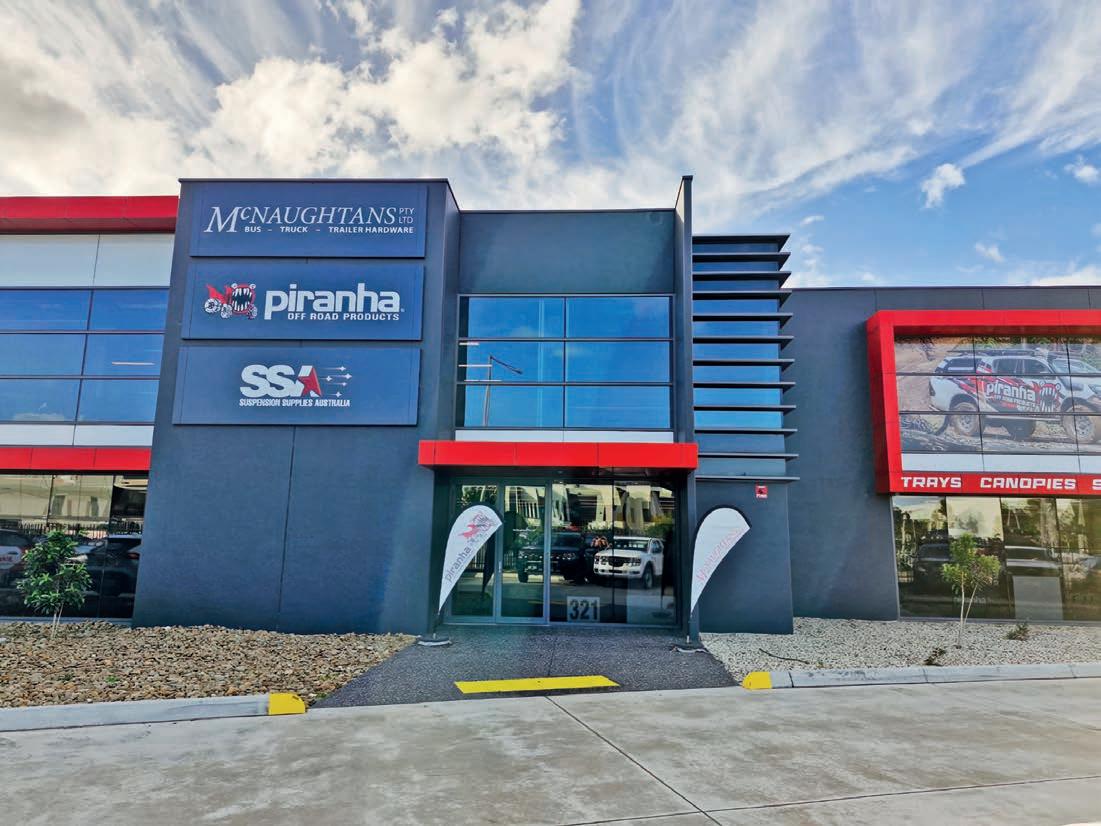

As Australia accelerates its transition to clean transport, global bus giant Yutong is planting the seeds of change
As the global conversation around climate change accelerates, some manufacturers are not just keeping pace but helping lead the way.
Yutong, one of the world’s largest bus manufacturers, is among those stepping up, embedding environmental accountability directly into its operations.
The Chinese-based company, which has been expanding steadily in Australia, is charting an ambitious course toward carbon neutrality which is anchored by its Net Zero Forest initiative and a robust global sustainability agenda.
On Earth Day 2025, Yutong marked a significant milestone in its long-term environmental roadmap. Under its Net Zero Forest program, the company has pledged to plant one tree globally for every bus added to its fleet. As Yutong grows commercially, it directly invests in global reforestation to offset
emissions, rehabilitate ecosystems, and inspire industry-wide change.
In 2024 alone, Yutong planted over 36,000 trees in regions including China, Chile, and the UK. For 2025, the company aims to increase that number to 47,000, part of a 10-year plan to plant millions of trees across key areas affected by environmental degradation.
The program exemplifies Yutong’s “Think Eco, Move Green” philosophy, where technological advancement and ecological responsibility go hand in hand.
“Sustainability is not just a goal for Yutong. It’s embedded in our DNA,” Yutong Bus global brand director Jason Huang says.
“Linking every bus on the road to measurable ecological impact allows us to visualise the journey from vehicle production to carbon reduction.”
In practice, this means more than just planting trees. Yutong’s afforestation work is guided by its “Double Carbon” model, which
pairs the promotion of zero-emission transport with the restoration of natural carbon sinks.
This approach supports global decarbonisation efforts while creating local environmental and social benefits.
In
2024 alone, Yutong planted over 36,000 trees in regions including China, Chile, and the UK
In arid areas like China’s Minqin Desert, Yutong is planting drought-resistant Haloxylon ammodendron trees, which combat desertification by stabilising sand and thriving in harsh conditions.
Closer to home, Yutong’s efforts in Australia reflect its global mission but are tailored to local priorities.
At the 2024 Green Mobility Week, Yutong showcased its
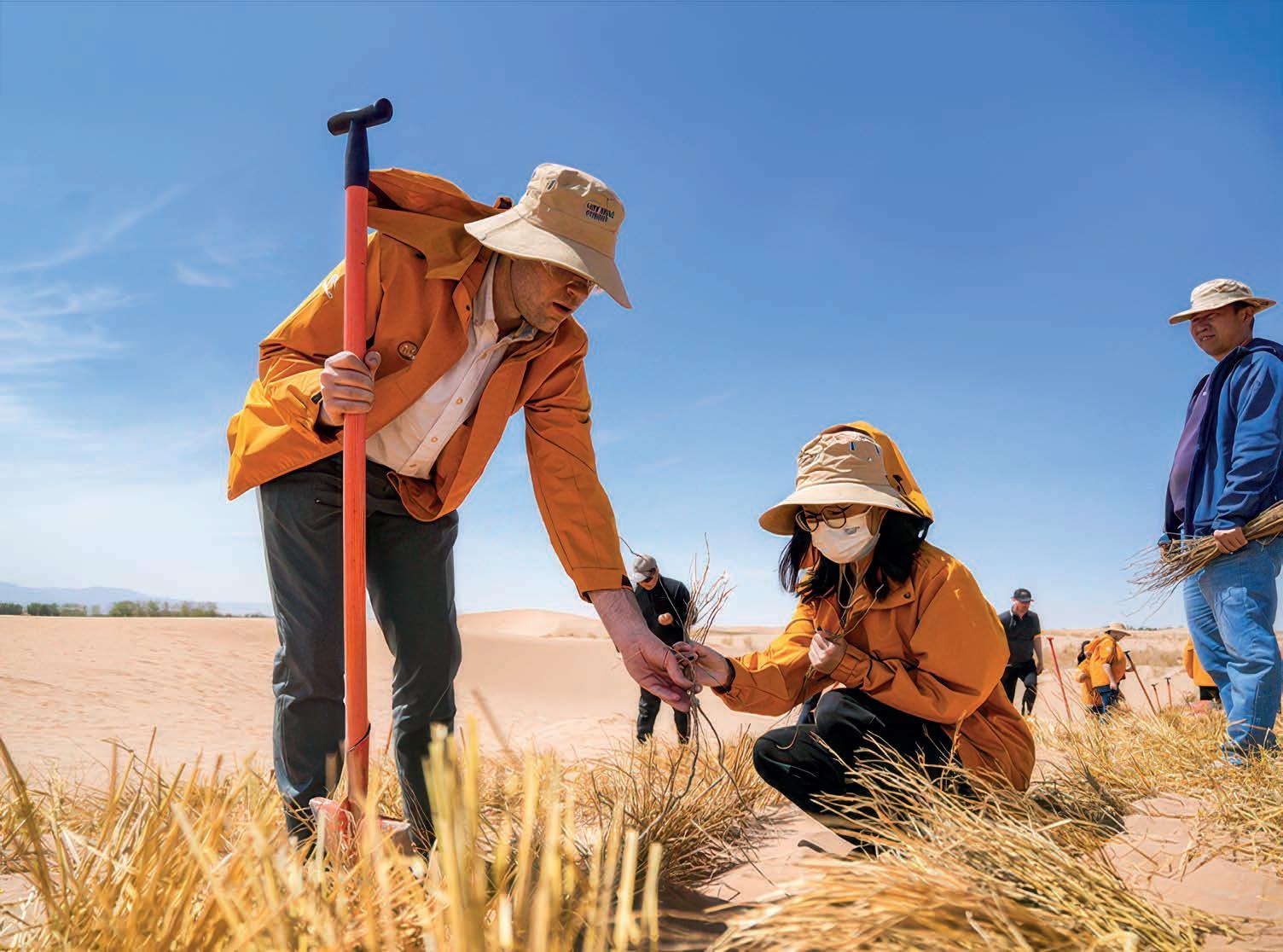
public transport systems, Yutong’s clean-energy buses are an increasingly popular choice, combining reliability with a lower carbon footprint.
The electric offerings are already making waves in Australian states such as New South Wales and Queensland, where transit authorities are investing in green fleets. These vehicles are not only reducing urban emissions but also helping to
These partnerships help accelerate innovation and encourage knowledge-sharing across borders, from South America to Southeast Asia to the Australian outback.
Australia’s unique environmental conditions and vast geography present both challenges and opportunities. Yutong is adapting by developing electric buses designed to handle long distances, extreme temperatures, and rural infrastructure
Below: The program xemplifies Yutong’s

leader in sustainable mobility. Its participation in international forums like COP26, where it showcased solutions for electrified public transport in the UK, reinforces its commitment to global best practices.
The company’s E12 electric bus has earned dual certifications from the UK’s Zemo Partnership and UTAC, meeting strict European standards for carbon emissions and energy efficiency.
In a market often dominated by cost and performance considerations, Yutong is adding environmental value. With its Net Zero Forest initiative, expanding Australian presence, and strong emphasis on clean technology, the company is redefining what leadership in the commercial vehicle industry looks like.
For Yutong, sustainability isn’t a side project, it’s central to its brand. As the world moves toward greener transport solutions, Australia is poised to benefit from Yutong’s experience, innovation, and unwavering commitment to a cleaner future.
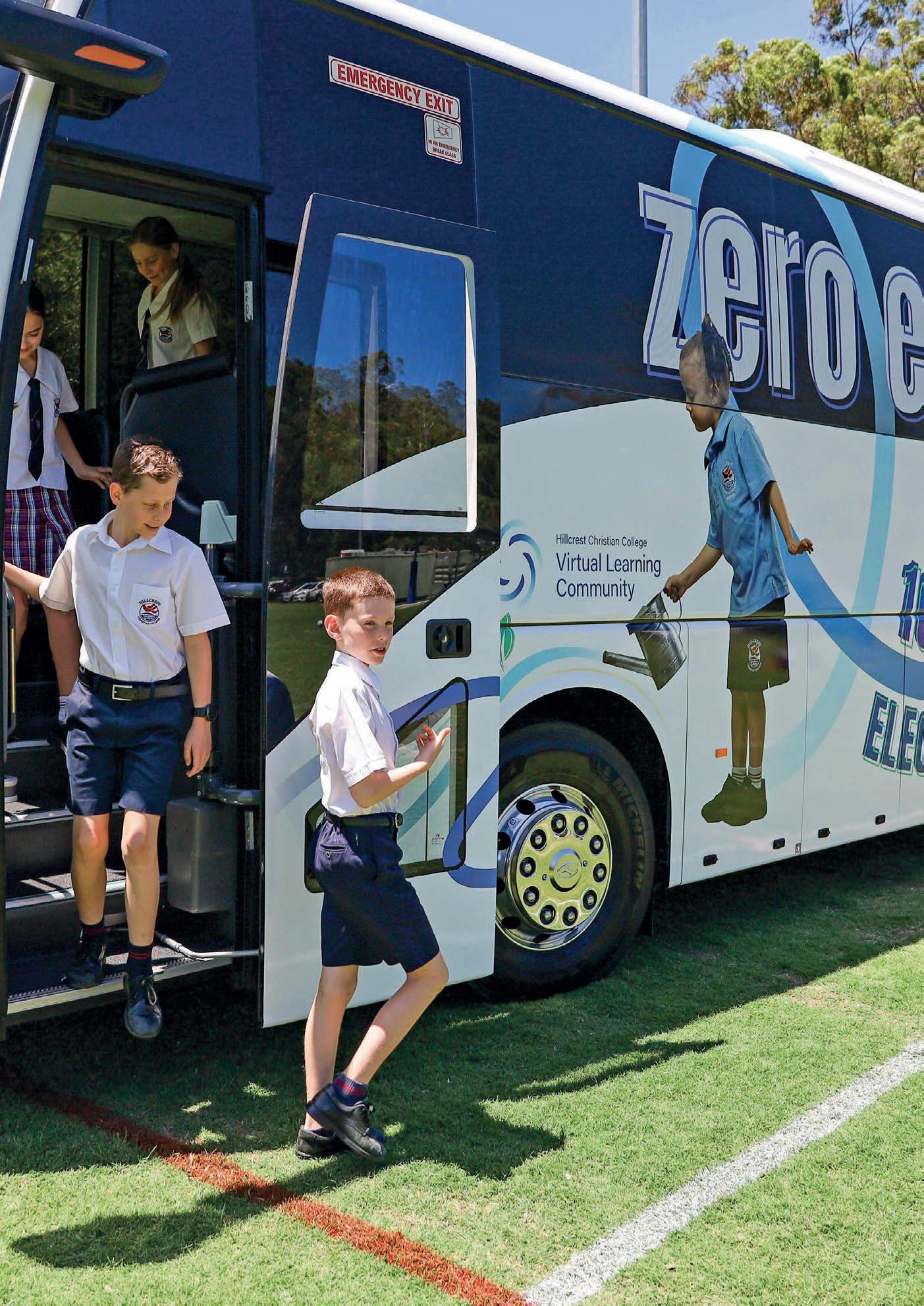
After two years in operation, Hillcrest Christian College, a leading Gold Coast School, is reaping benefits on its decision to add an electric bus to its fleet
Hillcrest Christian College is leading the charge in sustainable student transport with the introduction of an all-electric King Long coach.
The King Long EVolution 12.5m electric coach, supplied by Bus Stop Sales, marks not only a significant switch to electric, but a strong commitment to sustainability.
“For Hillcrest, this wasn’t a tick-the-box exercise,” Bus Stop Sales director Pete White told ABC
“They had a vision to align their transport operations with the values they teach in the classroom. To demonstrate leadership, innovation, and to highlight that sustainability was
everyone’s responsibility.”
King Long is no newcomer to zero-emission innovation. The global manufacturer launched one of the world’s first hybrid-energy coaches in 2001 and has since grown into one of the largest battery-electric bus producers globally.
The EVolution coach delivered to Hillcrest draws on decades of real-world operational experience, tailored to meet the specific needs of Australian operators.
“At its core, the coach features the King Long e-Drive system, an integrated high-performance drivetrain explicitly developed by the company for efficiency and reliability.”
Operational data captured through King Long’s standard telematics and additional monitoring technology revealed an impressive average energy consumption of just 0.85 kWh/ km under normal school operations.
Hillcrest uses the electric bus for morning and afternoon service and their intercampus shuttles during the day. The trip is eighty kilometres round trip, and it travels on both highways and in cities.
“This strong efficiency results not only in underlining the EVolution’s components are market leading but directly contributes to lower running costs, delivering both environmental and financial benefits for the College,” White says.

What sets this deployment apart is not just the technology, but the end-to-end support behind it
The King Long EVolution coach’s electric powertrain offers significant advantages for both operators and the environment.
The electric motor also runs much more quietly than traditional diesel engines and without vibration, contributing to a more pleasant experience for passengers.
“Electric coaches also have fewer moving parts than internal combustion vehicles, which can translate to lower maintenance costs and improved reliability,” White says.

For Hillcrest, the move to zero-emission transport wasn’t just a practical decision but a statement of values.
The College wanted to demonstrate to its pupils that environmental stewardship and social responsibility are not just classroom concepts, but real actions that shape the world around them.
EVolution also created an opportunity to showcase how the school’s extensive rooftop solar system, which generates its own renewable
solar-generated kilowatt-hours (kWh) to power student transport.
Hillcrest partnered with Bus Stop Sales to supply and operate a KEMPOWER DC charging system, backed by high-quality three-phase power upgrades.
technology
than a traditional supplier-customer relationship.
As schools, councils, and fleet operators across Australia plan their zero-emission journeys, the success of Hillcrest Christian College’s transition offers a clear blueprint:
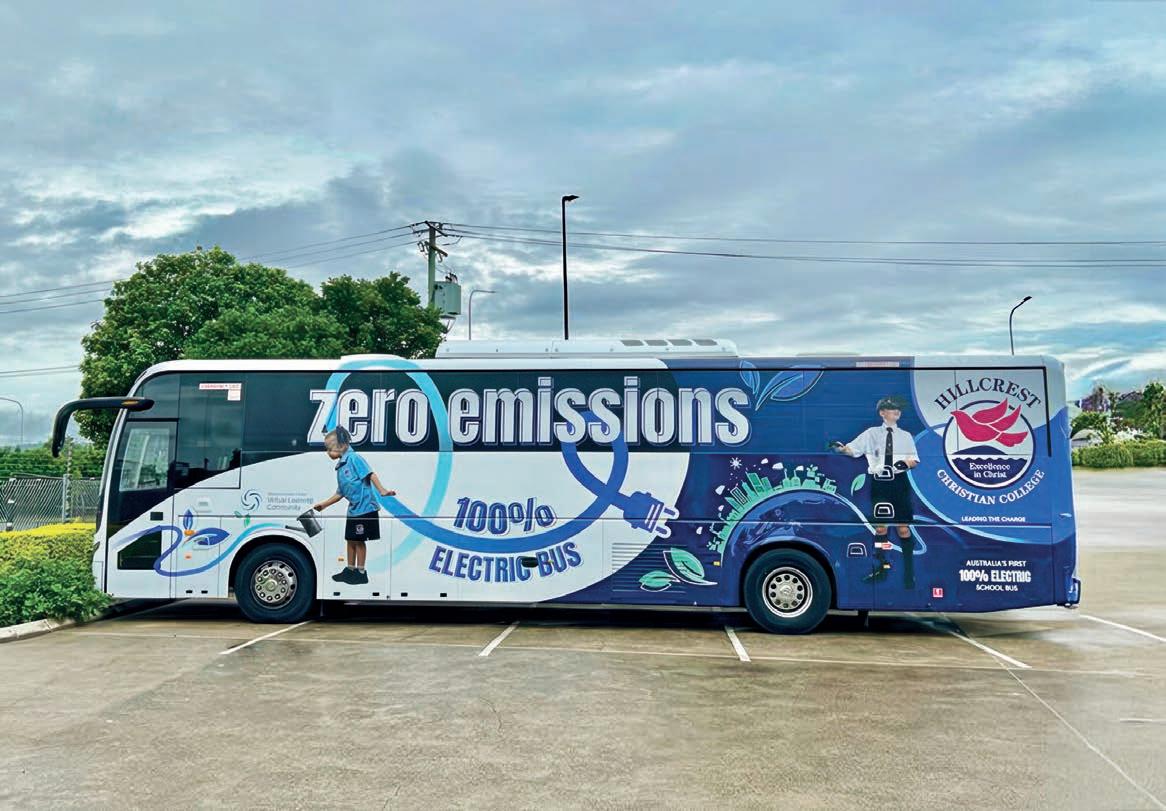
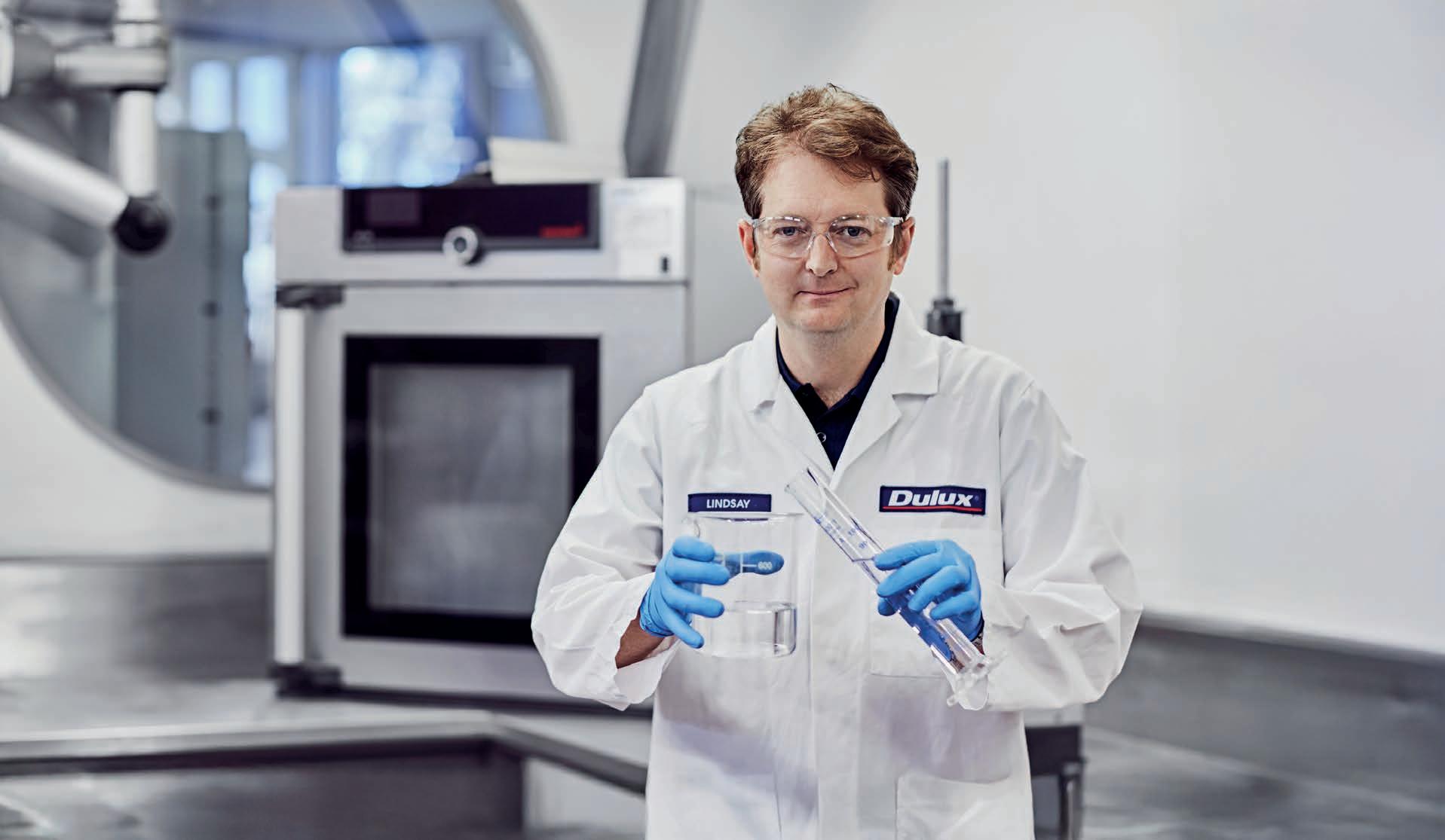
Dulux Automotive Coatings’ flagship range continues to deliver durable, consistent coatings that keep buses and coaches looking sharp
Every day, buses and coaches criss-cross cities and regions, braving everything from blinding sun and coastal salt spray to gravel flicked up from rural roads.
They’re mobile billboards for transport brands, public-facing symbols of reliability and vital links in the public transport chain. But keeping them looking sharp and operational requires more than routine cleaning and mechanical upkeep.
For many in the Australasian bus and coach industry, FleetShield, the flagship range from Dulux Automotive Coatings, has become the go-to premium system that ensures fleets
are always looking top of the range.
“FleetShield is more than just a paint system, it’s a complete solution designed to support fleet operators with repair, refurbishment and reimaging services,” Dulux senior chemist Lindsay Palmer told ABC
“Used widely across different segments of the bus and coach sector, the FleetShield range has earned its reputation as a durable, easy-to-apply and visually consistent system that meets the high expectations of today’s operators.”
The product range was recently revamped as part of Dulux’s effort to better organise the product range’s offering. Previously made up
of different brands, the range was consolidated to ensure ease of use and access for operators.
“We had heard some feedback from customers that the different product names were causing some confusion and so we have taken that feedback onboard and relaunched,” Palmer says.
“By bringing everything under one brand name, this confusion is eliminated, and the products are now easier to understand.”
The FleetShield paint range includes tint bases and high quality solid, metallic and pearl tinters – all ideal for modern fleets. A complete range of primers, hardeners
and thinners for large vehicles complement the range.
Bus and coach operators face unique challenges in maintaining the appearance and condition of their vehicles. From long hours on the road and exposure to harsh environmental elements, to stone chipping and UV degradation, the stresses on vehicle exteriors are significant.
FleetShield is engineered to handle exactly these types of wear and tear. Its high-durability formulation provides exceptional resistance to chipping and UV damage, ensuring that vehicles maintain a high-quality finish for longer.
“FleetShield was developed with these challenges in mind. It offers a durable finish that protects against the elements and helps reduce the need for frequent repairs,” Dulux Group technical manager Kathryn Murphy told ABC
“It’s a system that works hard so your vehicles can too.”
One of the most pressing concerns for fleet operators is downtime. Every hour a bus or coach spends off the road represents lost revenue and inconvenience to passengers.
FleetShield has been developed with ease-of-application in mind, making it an ideal system for quick turnarounds in both large workshops and smaller, on-site facilities.
The easy-to-use nature of the FleetShield system means that operators and applicators can reduce
vehicle turnaround time significantly.
In many cases, the efficient application process and fast-drying characteristics ensure minimal disruption to service schedules. This not only boosts operational efficiency but also increases vehicle availability, which is a key metric for fleet managers aiming to maximise productivity.
“Wanting to change up the look of a bus or fix some damages shouldn’t be a burden to operators,” Murphy says.
“That was a priority for us, ensuring our products were easy to apply and would stand the test of time.”
FleetShield’s topcoats offer operators the opportunity to paint their vehicles in different metallic and pearl colour effects without the need to use a base coat.
While fleet paint and ranges have historically been limited, Dulux has taken feedback from customers onboard and introduced new colours and finishes that are often only seen on passenger vehicles.
“Dulux’s colour team worked tirelessly to develop the colours and finishes that are now on offer,” Murphy says.
“We wanted to ensure that operator’s wants and needs were met, and that we could provide them with an unparalleled experience.”
One of the standout features of the FleetShield range is the Dulux Blueprint system, a
comprehensive system that ensures colour consistency and application standards are maintained across all vehicles, no matter where or when they’re painted.
“Dulux Blueprints specify colours which are approved by fleet managers and also include a comprehensive guide to the coating processes required for individual fleets,” Palmer says.
This is particularly valuable for larger operators managing vehicles across multiple depots or even states.
With the Blueprint in place and backed by Dulux sales and technical support teams in Australia and New Zealand, operators can be confident that their brand image will remain sharp and uniform.
“Our partnership with our applicators and distributors ensures those standards are always met,” Palmer says.
“You get the same finish, whether you’re in Cairns or Christchurch.”
With a strong reputation in the bus and coach industry and a growing presence across Australasia, FleetShield continues to prove itself as a smart investment for forwardthinking operators.
“It’s about more than just paint,” Murphy says.
“It’s about performance, consistency, support and ultimately helping our customers keep their fleets moving and looking great while they do it.”

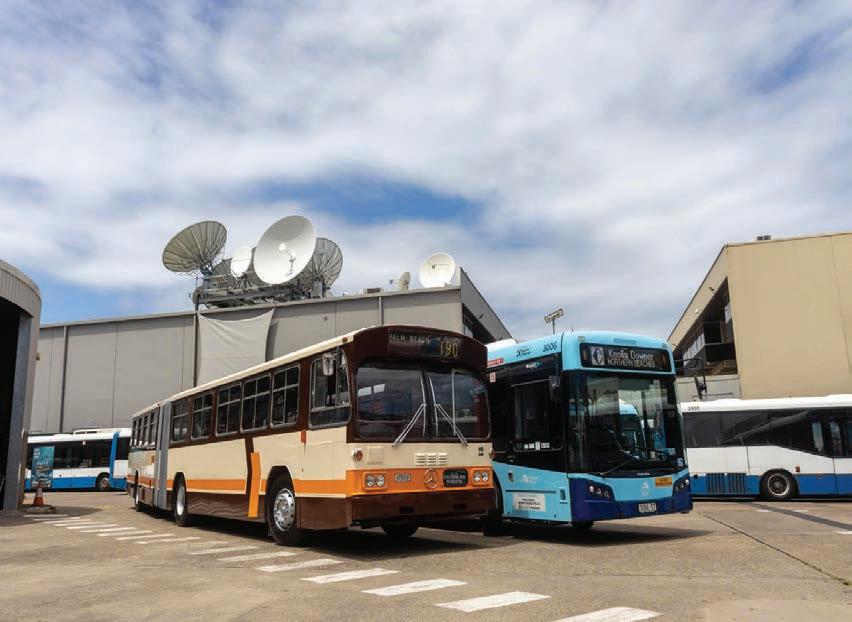


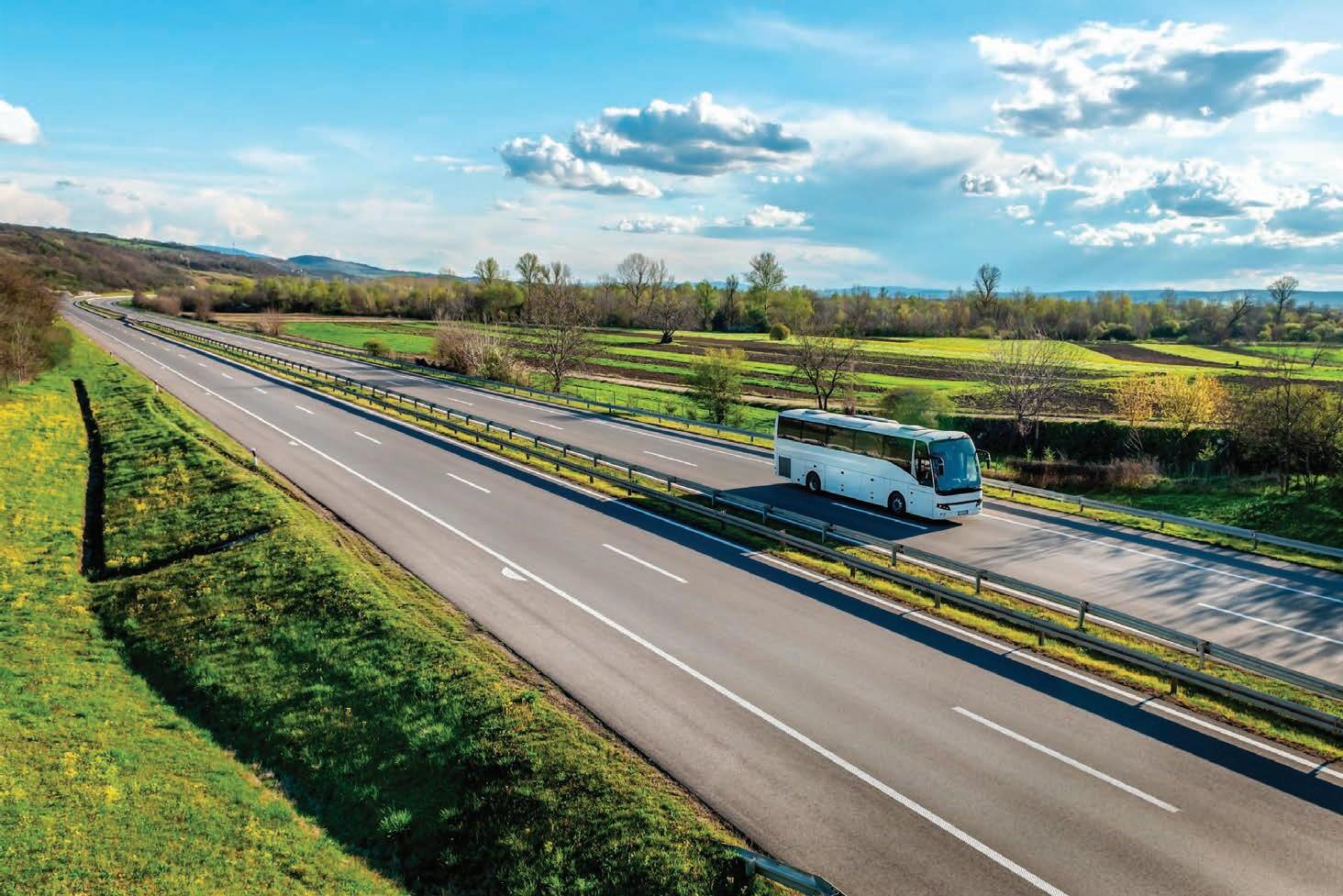
Send in your best bus or coach photos to feature in next month’s magazine.


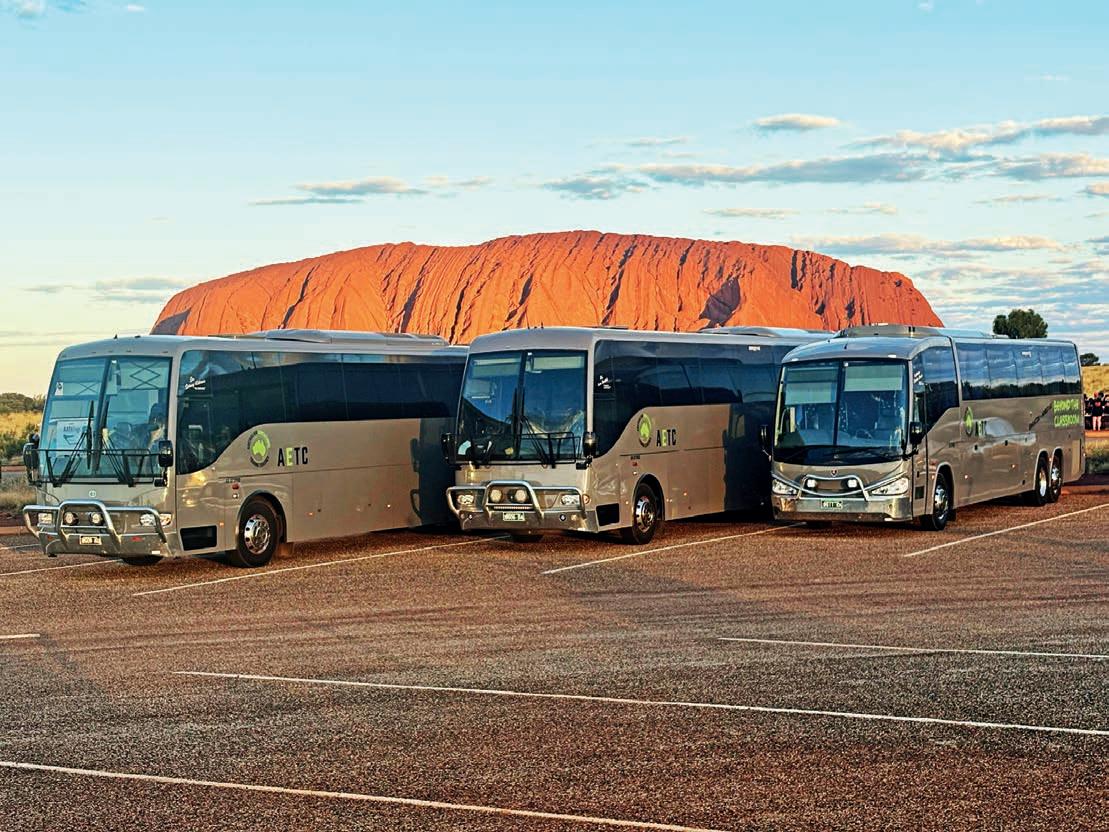
The winner of ABC ’s Best Bus May comes courtesy of John Louder and a dynamic shot of a bus trio in the NT
When driving through beautiful areas of the country, it would seem rude to not pull over for a quick picture of your bus in front of the sights.
With idyllic backdrops, stunning sunsets and more, it paints quite a pretty picture.
This month’s entries for ABC ’s Best Bus have done just that, showcasing not only some of the best buses hitting the roads, but some of the best sights you can see trapsing through Australia and New Zealand.
This month, the winner of ABC Best Bus May, John Louder, took us all the way to the Northern Territory.
Louder’s winning photo beat a hotly contested field, including numerous
entries from Newcombe Coaches which featured the Big Banana, Muttonbird Island, Coffs International Stadium and Coffs Wooden Jetty. Talk about taking a trip!
Grady Weatherley-Connell gave us a bit of a bus throwback with the ARA Heritage Buses group, showing off a 1989 MAN SG242 #2031 and 1994 MAN 11.190 #210 at the Silverdale yard following a bit of TLC by volunteers.
Joel Gorton snapped a sea of yellow on Sydney Bus Museum’s Westbus 40 years tour, showing that sometimes older is better.
But despite the incredible efforts, it was ultimately Louder who came out on top.
“We were lucky to have all three
Above: John Louder’s incredible shot of a trio of coaches in front of Uluru
coaches meet up at Uluru for the famous sunset over the rock and I thought that this was a great opportunity for a great shot,” Louder told ABC
“We actually had four of our coaches meet up, however we only have three in our fleet colours so moved one out for this photo.”
As the winner of Best Bus April, Louder has received a free 12-month subscription to ABC Magazine, while the winning photo is also being shown off as ABC ’s Facebook cover photo for the whole of the month.
Don’t forget to send through your Best Bus photos for June and throughout 2025 via email and keep an eye on our Facebook page for more details!
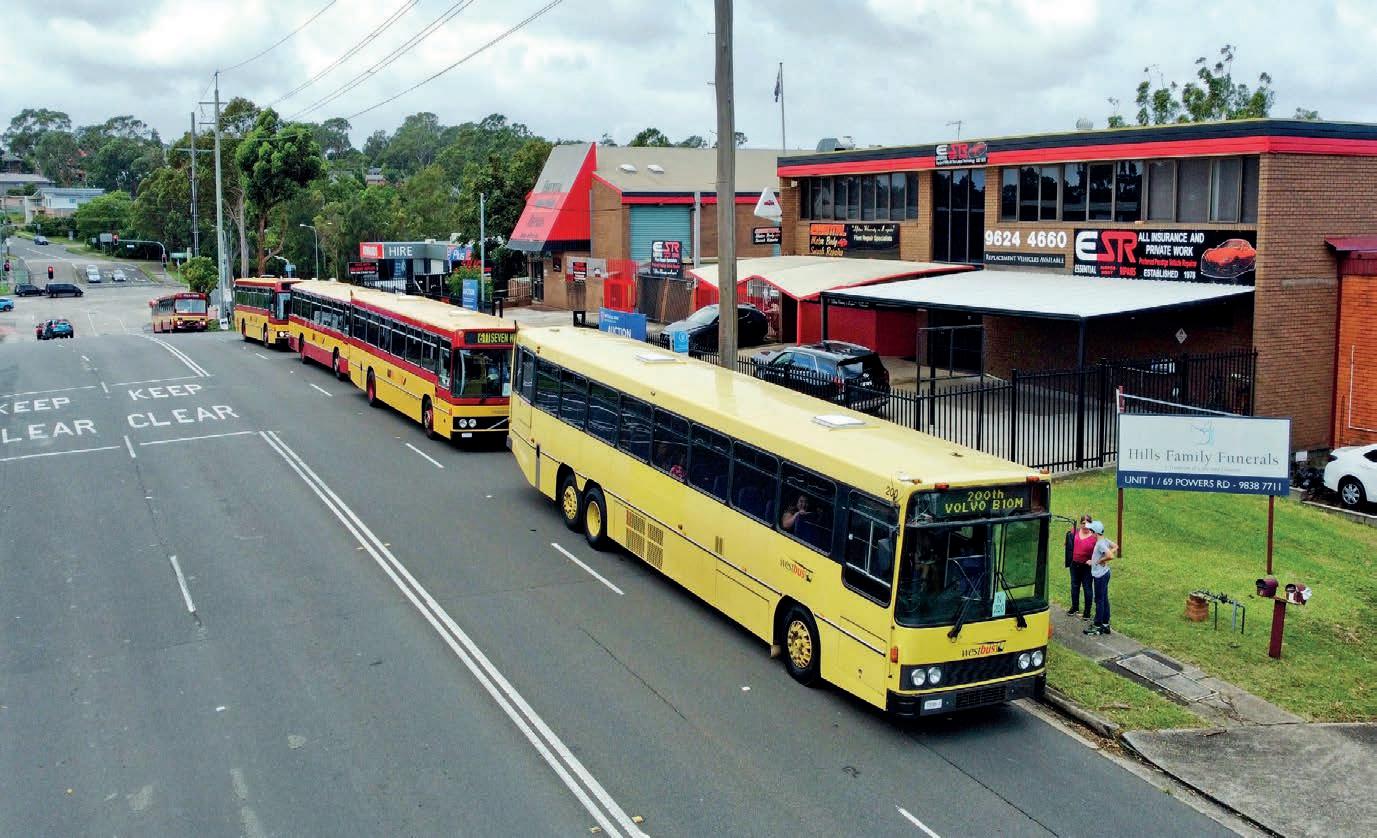

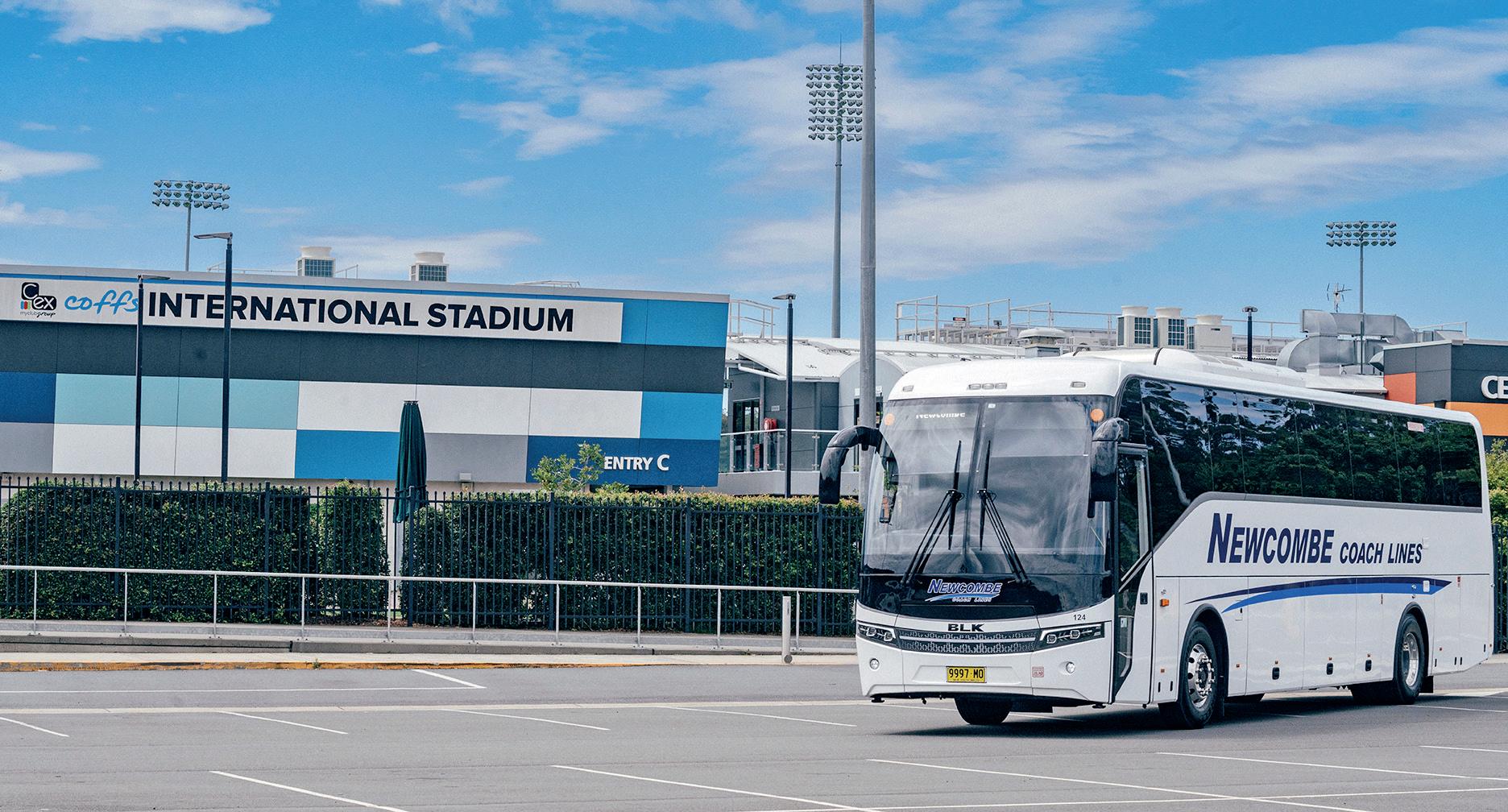




April’s bus and coach deliveries figures have received a boost as the industry enjoys a consistent start to 2025
After a quieter March, the nation’s bus and coach deliveries have started trending upwards yet again to match a busy January and February.
While March saw 123 units recorded, April improved to finish on 141 deliveries. While it’s a rise from last month, it falls narrowly short of April 2024, when 144 deliveries were recorded.
The chassis market once again clearly belonged to Volvo, who nearly doubled its March numbers of 45 deliveries to finish with 75 in April. It was far and away the sector leader, with Scania replacing Yutong in second with 21 deliveries for the month.
Yutong made sure it wasn’t too far behind with the 18 deliveries, including six D7 and D7E light bus units.
I-Bus recorded nine light bus deliveries, while King Long had seven heavy buses recorded. From there, BCI registered the four deliveries, MAN the three and BLK two, with Custom Denning and Challenger both having a solitary delivery each.
While Volgren had some tight competition in March, it returned to form in April as it once again secured a dominant top spot in the bodybuilder market with the 43 deliveries. Irizar came in second with the 20, while Yutong finished third with its 18 deliveries. Custom Denning wasn’t far behind with 11, while I-Bus and BCI both recorded nine. King Long (seven) kept its nose ahead of BLK (six) and Coach Concepts (four), with a remaining six brands claiming the final 14 deliveries.
The industry has become used to McConnell dominating the seating segment, with the Victorian-based supplier romping away to a commanding lead with 60 April deliveries. Sege secured a comfortable second with 35, leaving

Yutong in third with 12. APM snatched fourth with nine deliveries, while StyleRide (eight) kept ahead of King Long (seven) and BusTech (six). At the end, Marcopolo (three) and Fainsa (one) remained consistent in their deliveries.
Despite Cling-Yutong claiming March honours, the always competitive HVAC market took another turn in April as Thermo King returned to the top with 31 deliveries. It was a fiercely fought month, with Hispacold claiming second with 27 units while Cling-Yutong dropped to third with 18. Coachair (17) remained hot on its heels, with Valeo (14) also not far behind. Below them, Songz (nine) had a strong month, as did MCC (eight), while King Long (seven) stayed ahead of a pack of four brands that split the final 10 deliveries between them.
Much like in the air-conditioning sector, Australia’s states and territories
continue to closely battle it out for top spot. Queensland confirmed its return to number one in April, following it up with 41 deliveries in April. Victoria rose to snatch second with 30 and WA claimed third with 27, while NSW dropped from top spot in March to fourth in April with 23 deliveries. South Australia’s strong month saw 14 deliveries while the ACT welcomed six new buses to the fold in April. When it comes to the comparison between diesel and electric vehicles, nine of the 141 April deliveries were electric, down from the 27 recorded in March. Yutong (seven) claimed top spot in that market ahead of Volvo (one) and BCI (one). On the diesel side, Volvo dominated with 74 out of the 132 diesel units for the month, with Scania (13) and Yutong (11) well behind. The former also recorded eight deliveries in the diesel hybrid segment.
While Volgren had some tight competition in March, it returned to form in April as it once again secured a dominant top spot in the bodybuilder market with the 43 deliveries. Irizar came in second with the 20, while Yutong finished third with its 18 deliveries.
The industry has become used to McConnell dominating the seating segment, with the Victorian-based supplier romping away to a commanding lead with 60 April deliveries. Sege secured a comfortable second with 35, leaving Yutong in third with 12.
On the diesel side, Volvo dominated with 74 out of the 132 diesel units for the month, with Scania (13) and Yutong (11) well behind. The former also recorded eight deliveries in the diesel hybrid segment.
The chassis market once again clearly belonged to Volvo, who nearly doubled its March numbers of 45 deliveries to finish with 75 in April. It was far and away the sector leader, with Scania replacing Yutong in second with 21 deliveries for the month. Yutong made sure it wasn’t too far behind with the 18 deliveries, including six D7 and D7E light bus units.
BCIToyotaFleetManagementWA1BCIFleetmasterEVBCIME18t422kWRZero BCIKineticWA1BCICitirider10BCIME14t290REuro6 BCIKineticWA1BCIPromaLowFloorBCIME11.8t220REuro6 BCIATGWA1BCICitirider10BCIME14t290REuro6 BLKN/AVIC2BLKBLKPresident2ME18.5t360REuro5 ChallengerBusandCoachJPTTourGroupQLD1ChallengerV12ChallengerME18.5t360REuro6 CustomDenningN/ANSW1CustomDenningCustomDenningME18t340CEuro5 I-BusN/AVIC1IsuzuI-BusAustralasiaME8.7t190FEuro5 I-BusN/AVIC1IsuzuI-BusAustralasiaME8.7t190FEuro5 I-BusN/AVIC1IsuzuI-BusAustralasiaME8.7t190FEuro5 I-BusN/AQLD1IsuzuI-BusAustralasiaME8.7t190FEuro5 I-BusN/AQLD1IsuzuI-BusAustralasiaME8.7t190FEuro5 I-BusN/AQLD1IsuzuI-BusAustralasiaME8.7t190FEuro5 I-BusN/AQLD1IsuzuI-BusAustralasiaME8.7t190FEuro5
I-BusN/AQLD1IsuzuI-BusAustralasiaME8.7t190FEuro5
I-BusN/AQLD1IsuzuI-BusAustralasiaME8.7t190FEuro5
KingLongN/AVIC1KingLongKingLongME14t250REuro5
KingLongN/AQLD1KingLongKingLongME14t250REuro5
KingLongN/AQLD1KingLongKingLongME14t250REuro5
KingLongN/AQLD1KingLongKingLongME18t360REuro5
KingLongN/AQLD1KingLongKingLongME18t360REuro5
KingLongN/AQLD1KingLongKingLongME18t360REuro5
KingLongN/AQLD1KingLongKingLongME18t360REuro5
MANSurfsideBuslinesQLD3MANLE.19.330.RC2GlobalBusVenturesME19.5t330REuro6 ScaniaB&GChristianVIC1ScaniaK370CB4x2NBScaniaHigerME19.5t370REuro6 ScaniaBus&CoachInternationalQLD2ScaniaK320CB4x2NBBCIME19.5t320REuro6 ScaniaBusQLDQLD1ScaniaK320CB4x2LBVolgrenME20.2t320REuro6 ScaniaDepartmentforInfrastructureandTransportSA2ScaniaK320HB4x2LBBusTechGroupME20.2t320REuro6 ScaniaDriverGroupAustraliaVIC1ScaniaK360CB4x2NBScaniaHigerME19.5t360REuro6 ScaniaDepartmentforInfrastructureandTransportSA6ScaniaK320HB4x2LBVolgrenME19.5t320REuro6 ScaniaHorshamBusLines/WimmeraRoadwaysVIC2ScaniaK320CB4x2LBVolgrenME20.2t320REuro6 ScaniaIrizarAsiaPacificQLD1ScaniaK320CB4x2NBIrizarME19.5t320REuro6 ScaniaIrizarAsiaPacificVIC1ScaniaK320CB4x2NBIrizarME19.5t320REuro6 ScaniaMLGGasQLD1ScaniaK360CB4x2NBCoachConceptsME19.5t360REuro6 ScaniaVenturaBusLinesVIC1ScaniaK360CB4x2NBScaniaHigerME19.5t360REuro6 ScaniaWarrnamboolBusLinesVIC1ScaniaK320CB4x2NBCoachDesignME19.5t320REuro6 ScaniaWG&SMHeadingQLD1ScaniaK370CB4x2NBIrizarME19.5t370REuro6 VolvoMurraysCoachesNSW3VolvoB8RBCIME19t350REuro6 VolvoPremierMotorServiceNSW3VolvoB8RLEVolgrenME19t320REuro6 VolvoSydneyCoachCharterNSW1VolvoB8RMarcopoloME19t350REuro6 VolvoLangleysCoachesNSW1VolvoB11RIrizarME26t450REuro5 VolvoMacquarieEducationalToursNSW1VolvoB11RIrizarME26t450REuro5 VolvoCDCRADNSW2VolvoB11RIrizarME26t450REuro5 VolvoLinkSASA1VolvoB8RBCIME19t350REuro6 VolvoCDCQLDQLD6VolvoB8RLEVolgrenME19t320REuro6 VolvoCDCB&EBlanchNSW1VolvoB8RVolgrenME19t320REuro6 VolvoBuswaysNSW10VolvoB8RLECustomDenningME19t320REuro6 VolvoFlagstaffBusLinesSA2VolvoB11RIrizarME26t450REuro5 VolvoVenturaBusLinesVIC10VolvoB8RLEVolgrenME19t330REuro5 VolvoNulineCharterVIC1VolvoB11RCoachConceptsME26t410REuro5 VolvoSunburyBusLinesVIC1VolvoB11RIrizarME26t450REuro5 VolvoCobdenBuslinesVIC1VolvoB8RBCIME19t350REuro6 VolvoSeymourPassengerServiceVIC1VolvoB11RCoachDesignME26t410REuro5 VolvoITRIPTravelVIC1VolvoB8RIrizarME19t350REuro5
VolvoRoyalDiscoveryHolidayVIC1VolvoB8RIrizarME19t350REuro6 VolvoLinkSASA1VolvoB8RBCIME19t350REuro6 VolvoCarrisonVIC1VolvoB8RCoachConceptsME19t350REuro6 VolvoKangaCoachLinesSA1VolvoB13RCoachConceptsME26t500REuro6
VolvoMunnsBusServiceWA2VolvoB8RMarcopoloME19t350REuro6
VolvoPublicTransportAuthorityWAWA9VolvoB8RLEVolgrenME19t320REuro6 VolvoPublicTransportAuthorityWAWA1VolvoBZLElectricVolgrenME19tN/ARZero VolvoKangarooBusLinesQLD2VolvoB11RIrizarME26t450REuro5 VolvoKangarooBusLinesQLD1VolvoB8RLEBCIME19t350REuro6 VolvoFunOverFiftyQLD1VolvoB11RIrizarME19t450REuro5 VolvoThompsonCharterServicesQLD3VolvoB13RIrizarME26t500REuro6 VolvoKangarooBusLinesQLD4VolvoB8RLEVolgrenME19t320REuro6 VolvoPinnacleTravelGroupWA2VolvoB11RIrizarME26t450REuro6 YutongYutongBusCentreBrisbaneQLD1YutongD7YutongME8t190FEuro6 YutongYutongBusCentreMelbourneSA1YutongD7YutongME8t190FEuro6 YutongYutongBusCentreWAWA4YutongC12YutongME18t340FEuro6 YutongYutongBusCentreWAWA3YutongD7YutongME8t190FEuro6 YutongYutongBusCentreWAWA2YutongC10YutongME13.6t310REuro6 YutongYutongBusCentreSydneyACT6YutongE12YutongME18t350N/AN/A YutongYutongBusCentreBrisbaneQLD1YutongD7EYutongME8t190N/AN/A
AN/A212.3Coachair–53––X–––SegeBCIYN AZF210.1MCC33–––––X–SegeBCIYY AZF28.9MCC33–––––X–SegeBCIYY AZF210.1MCC33–––––X–SegeBCIYY AAllison212.36ThermoKing57––XX–––SegeN/ABLKN/A AAllison212.3ThermoKing–57––X–––FainsaChallengerYN/A AAllison212.3Spheros57–––––X–SegeCDYN ASIsuzu28.3Songz32–––––X–APMSASDoorsYN ASIsuzu28.3Songz32–––––X–APMSASDoorsYN ASIsuzu28.3Songz32–––––X–APMSASDoorsYN ASIsuzu28.3Songz32–––––X–APMSASDoorsYN ASIsuzu28.3Songz32–––––X–APMSASDoorsYN ASIsuzu28.3Songz32–––––X–APMSASDoorsYN ASIsuzu28.3Songz32–––––X–APMSASDoorsYN ASIsuzu28.3Songz32–––––X–APMSASDoorsYN ASIsuzu28.3Songz32–––––X–APMSASDoorsYN AZF29KingLong35–––X–––KingLongKingLongYN AZF29KingLong39–––X–––KingLongKingLongYN AZF29KingLong39–––X–––KingLongKingLongYN AZF212KingLong–53––X–––KingLongKingLongYN AZF212KingLong–53––X–––KingLongKingLongYN AZF212KingLong–53––X–––KingLongKingLongYN AZF212KingLong–53––X–––KingLongKingLongYN AZF212.5Valeo––46––X––McConnellVenturaNN AZF212.5Konvekta58–––––X–McConnellN/AYN AZF212.3MCC57–––––X–SegeN/AYN OpticruiseScania212.5ThermoKing––45––X––StyleRideN/ANN OpticruiseScania212.5Hispacold45––––X––McConnellN/ANN AZF212.3Konvekta58–––––X–McConnellN/AYN OpticruiseScania212.5Hispacold45––––X––BusTechGroupN/ANN AZF212.3Coachair––47––X––McConnellN/ANN AZF212.5Hispacold57–––––X–SegeN/AYN AZF212.5Hispacold57–––––X–SegeN/AYN OpticruiseScania211ThermoKing–57––––X–SegeN/AYN AZF212.3Konvekta–54––––X–McConnellN/AYN AZF212.5ThermoKing57–––––X–McConnellN/AYN OpticruiseScania212.3Hispacold57–––––X–SegeN/AYN AZF212.3MCC–48–X––––SegeBCIYY AZF212.3ThermoKing––43––X––McConnellSMCNY AZF212.3Spheros57–––X–––MarcopoloMarcopoloYN ASVolvo313.5Hispacold–50–X––––SegeIrizarYY ASVolvo312.5Hispacold–48–X––––SegeIrizarYY AZF313.5Coachair54–––X–––McConnellIrizarYY AZF210-12.9Husky51––––X––SegeBCIYY AZF210-12.9Coachair––43––X––McConnellVenturaNY AZF210-12.9Coachair54–––––X–McConnellSMCYN AZF210-12.9ThermoKing55–––––X–McConnellSMCYN ASVolvo313-14.9Hispacold–55––X–––SegeIrizarYY AZF210-12.9Valeo––44––X––McConnellVenturaNY ASVolvo210-12.9Valeo57–––X–––McConnellSMCYN ASVolvo313-14.9Hispacold–54––X–––SegeIrizarYY AZF210-12.9Hispacold57–––––X–SegeIrizarYN ASVolvo210-12.9ThermoKing–57––––X–McConnellSMCYN AZF210-12.9Hispacold57–––X–––SegeIrizarYN AZF210-12.9Hispacold–53––X–––SegeIrizarYN AZF210-12.9Husky57–––––X–SegeBCIYN AZF210-12.9ThermoKing57–––––X–McConnellSMCYN ASVolvo313-14.9ThermoKing–50––X–––SegeSMCYN AZF210-12.9Spheros43–––––X–MarcopoloMarcopoloYN AZF210-12.9ThermoKing––41––X––McConnellSMCYN AVolvo210-12.9Denso––32––x––McConnellVenturaNY ASVolvo313-14.9Hispacold–57–X––––SegeIrizarYY AZF210-12.9Coachair51–––X–––SegeBCIYY ASVolvo113-14.9Hispacold–46–X––––StyleRideIrizarYN ASVolvo313-14.9Hispacold65–––X–––SegeIrizarYY AZF210-12.9Coachair––43––X––McConnellVenturaNY ASVolvo313-14.9Hispacold–56–X––––SegeIrizarYY AAllison27.7Cling-Yutong27––––X––YutongYutongYN AAllison27.7Cling-Yutong27–––X–––YutongYutongYN AAllison212.3Cling-Yutong57–––X–––YutongYutongYN AAllison27.7Cling-Yutong28–––––X–YutongYutongYN AZF29.9Cling-Yutong43–––––X–YutongYutongYN N/AN/A212.4Cling-Yutong––44––X––StyleRideYutongN/AY N/AN/A27.7Cling-Yutong28–––X–––YutongYutongYN

A retired 1977 Leyland Atlantean has found a second life as the Funpad, a fully mobile soft play centre delighting kids and surprising parents across Melbourne
What do you get when you cross a vintage double decker bus with a soft play centre? A whole lot of happy kids and one very clever business idea.
The Funpad is a fully mobile indoor play centre based in Melbourne, able to be hired for birthday parties, gatherings and more.
Founded by Gary, the idea came about after watching existing mobile play centres in action.
“They were great, but every time they had to set up, it took four or five hours. And then another long pack-down before they could move to the next spot,” Gary told ABC That sparked the big idea – what if the play centre was already built inside a bus?
A few bus-yard searches later, Gary found what would become the first Funpad, a classic 1975 Leyland Atlantean double decker bus. While it had been sitting idle for years, collecting dust, he saw the potential.
With help from a small army of professionals, builders, soft play specialists, window seal experts, mechanics and painters, Gary brought the old Atlantean roaring back to life.
“The set up was all custom,” he says.
“We had to rebuild the engine, refit the interior and coordinate with different vendors. It took a lot of people coming together to make it happen.”
The business originally kicked off in Perth, before relocating to Melbourne during the pandemic.
From the outside, the Funpad looks like a charming retro bus, but step inside and it’s a whole different story.
“People are always shocked,” he says.
“They see a bus and think there would be no way a whole play centre could fit inside. But when they step inside, they are instantly blown away.”
The space is split into three creative play levels. The top deck is used as a play area, the main level is packed with
Above:
The Funpad has been bringing smiles to kids’ faces for over a decade.
Image: The Funpad
soft play equipment, and there’s even a hidden tunnel that runs through the former luggage compartment below.
“It’s like a secret hideout,” he says. “Kids love crawling through it and it’s always a big hit.”
Launched officially in 2015, the Funpad has since become a regular sight at birthday parties, community events and even classic car shows.
“We go to retro car events to entertain the kids, but the bus fits right in with all the vintage vehicles. People love seeing it, especially those who remember these buses on the road.”
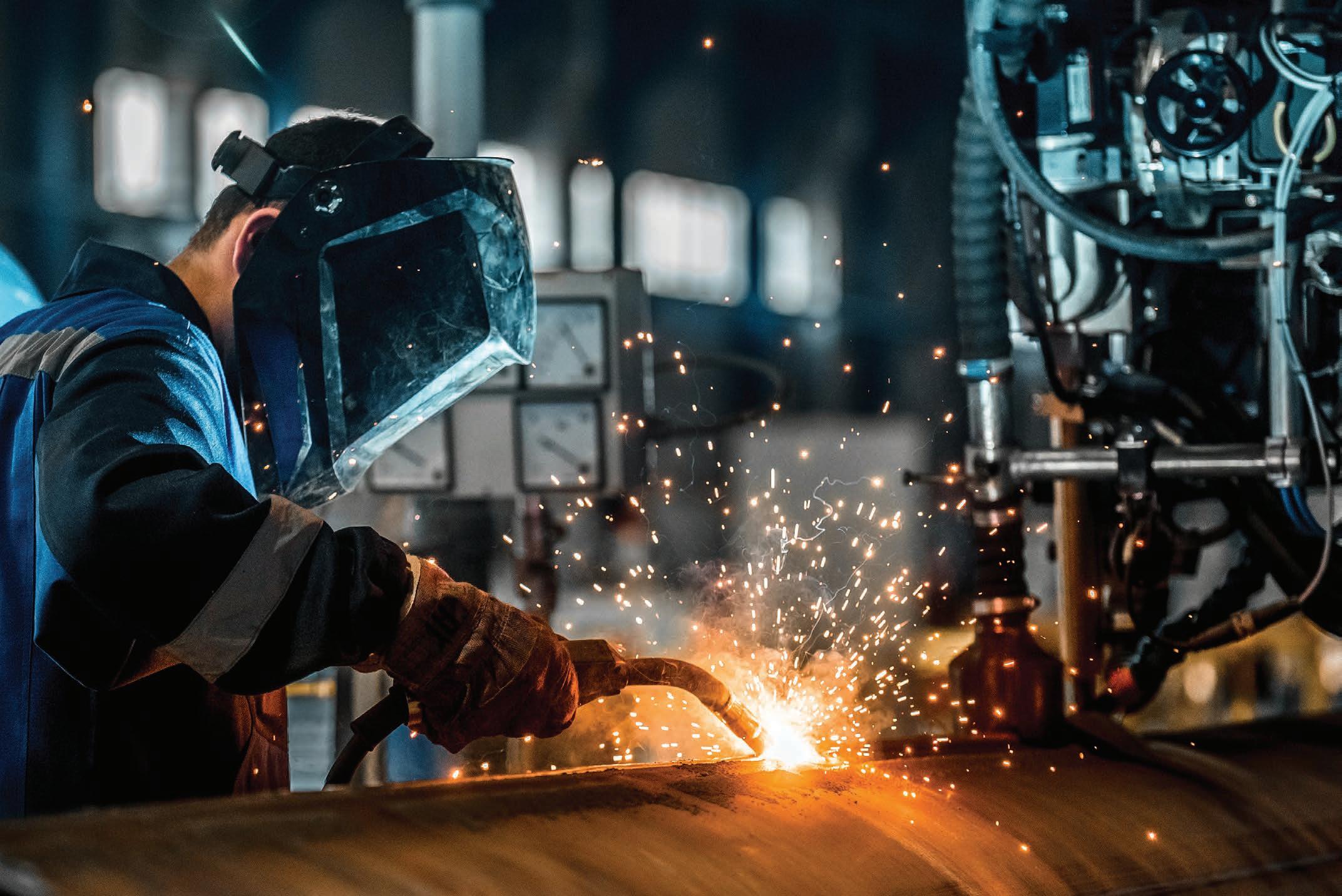
Now in its 10th year, the Funpad continues to surprise and delight families across Melbourne.
“We’ve had so many repeat customers and referrals,” Gary says.
“The biggest challenge is just getting people to see it in person. Once they do, they get it.”
For a business born from an old bus and a clever idea, the Funpad proves that sometimes the best adventures really do start from the back seat.


